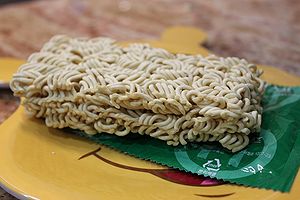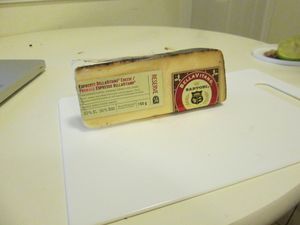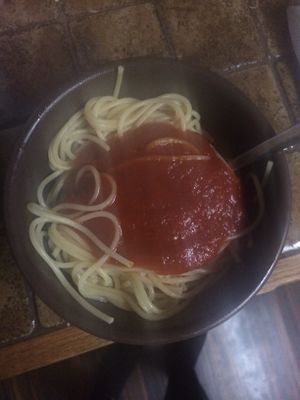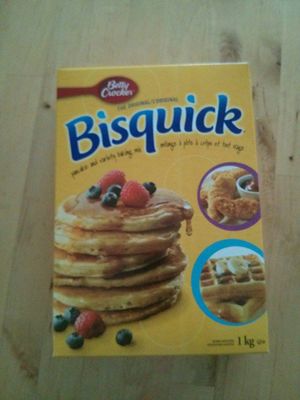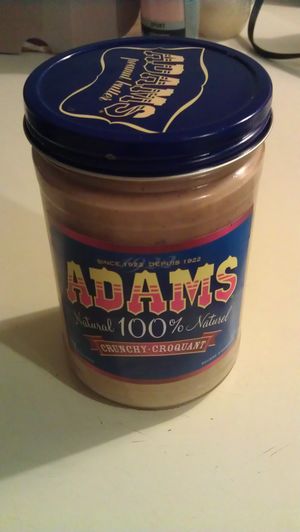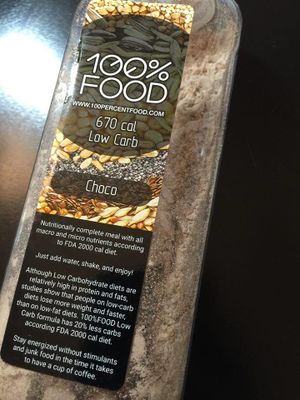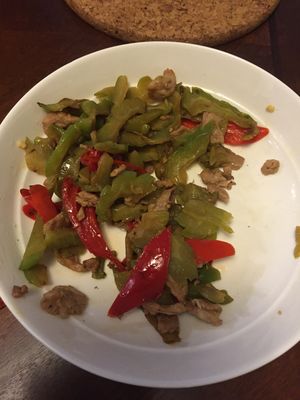Course:FNH200/2015w2/Assignment01
FNH 200 2015W Assignment #01 and 03
Assignment #3
A Reflection on Learning
Due Date: Friday, April 15, 3:30 pm
This is a time to revisit what you wanted to learn and questions you had about foods at the beginning of the course. Here is what I expect you to do as your last assignment for FNH 200, 2% of total grade.
- Revisit the questions you asked at the beginning of the course (in alphabetical order of your last name below)
- Are you able to answer them?
- If yes, please answer your own questions to your best ability. Please also provide the Lesson # that associates with your answer.
- If not, try to make connections with concepts you've learned. Educated guesses are welcome, but no wild guess please. You may want to speculate where you may be able to find the answer to your questions, such as academic/research literature, government websites, food associations sites, health organizations, etc. Answers such as 'I will google it later' is definitely not enough :) .
- Add your answers (or most educated speculations) directly underneath your original questions.
An example on instant noodle is provided below. I've tried to answer the questions as a 'good' 2nd year FNH 200 student :)
Assignment #1 (Original Instructions from January)
Due Wednesday, January 20, 2016, 5:00 pm
The learning goals of Assignment #1 are to help you:
- familiarize yourself with UBC Wiki and wiki markup language by
- logging into UBC wiki
- uploading a photo of a food (see links to 'how to upload' below)
- posting required responses on a pre-set UBC wiki table
- connect personal experience with course content
Assignment #1 Activities
| Option A | Option B |
|---|---|
|
|
**An Example on Instant Noodle**
Family Names that Start with 'A'
Family Names that Start with 'B'
| Your Wiki ID | Photo of the Food | Option A: What happened? Option B: Why Did You Select This Food? |
Questions You Have |
|---|---|---|---|
| Benjamin Beaver | 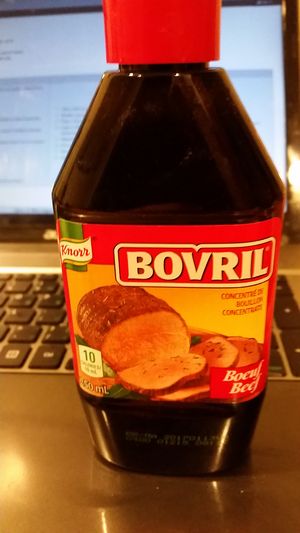 |
I chose this product because it's tasty and really useful in day to day cooking. | 1. What is hydrolyzed soy?
2. How is the water content of the stock reduced without affecting flavour? 3.What kinds of flavourings might be in this product? 4. How does one make beef extract? 5. How does the process of making stock on a commercial level differ from that of making it at home? |
| Laura Brager | 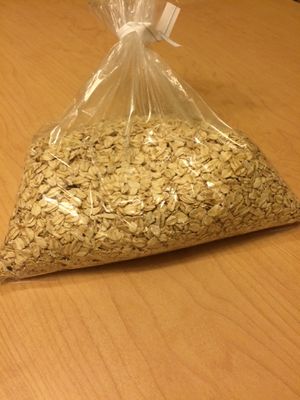 |
I chose this food because I eat rolled oats with my cereals, yogurt and milk daily for breakfast and for snacks. I also sometimes used them to make granola, cookies and muffins. | 1. How are these oats further processed to make "quick oats"?
2. How are they pressed/processed from their original form? 3. What is the process to "de-husk" the oat groats from which the rolled oats originate? 4. Does the cooking time they undergo affect their nutritional value? 5. Since these oats were found in the bulk food section of the grocery store, were they processed any differently than the rolled oats you might find on the store shelf? Assignment #3 Answers: 1. While this topic was not directly discussed in class, I did my own research to find the answer to this question. As Food.com discusses, rolled oats are groats, a form of grain, that have been steamed and rolled from steel-cut oats to decrease cooking time. These rolled oats, as I discovered from food bloggers and other research sites, can be further rolled and cut even finer to decrease cooking time even further. They can be rolled by hand or with a machine. SOURCES: http://www.food.com/about/oatmeal-465 http://www.thekitchn.com/whats-the-difference-between-steel-cut-rolled-and-instant-oats-138355 2. Once again, this topic was not covered in our lessons, but with my own research I was able to discover an answer. As the Whole Grains Council states, the raw oats are harvested while still attached to the original hulls and stalks. The inedible hulls are then removed to create whole oat groats. By cutting the groats into two or three pieces, steel-cut oats can then form. Then, the rolled oats can be created when the oat groats are steamed and rolled into flakes. SOURCES: http://wholegrainscouncil.org/whole-grains-101/types-of-oats 3. The Whole Grains Council also goes into detail on the de-husking process for oats. First, they undergo cleaning by various machinery that separate the unwanted materials from the quality oats. The second step is the hulling process, where the outer hull is removed from the inner groat by large machines. As the Whole Grains Council describes, this can be done by throwing the oats against a rubber ring, which removes the hull without damaging the groat. SOURCES: http://wholegrainscouncil.org/whole-grains-101/types-of-oats 4. The answer to this question is similar to many topics discussed in Lesson 11 on the effects of processing on nutritive value of foods. With further research, I discovered that there is no change in the nutritional value when comparing steel-cut oats and regular oats, as they are both derived from the same oat groat. While steel-cut oats take longer to cook as they are thicker, the cooking of oats does not affect their nutrition profiles. SOURCE: http://healthyeating.sfgate.com/relative-benefits-steelcut-vs-quick-oats-11364.html 5. As discussed in Lesson 5 on food preservation, the oats are thought to be a shelf-stable food with a shelf life of more than 6 months. Therefore, there is little need for any preservation methods to be used to lengthen the storage life of both bulk oats and pre-packaged oats. The pre-packaged oats are simply available in this format for convenience, and may have additional added ingredients to enhance taste and flavor. |
| Lizl Bonifacio | 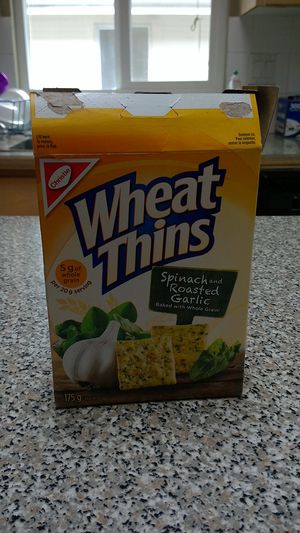 |
I chose this food item because it is a snack that I really enjoy eating. It's quick and easy to pack if I have to go to school or work and they taste really good! | 1. What is the actual vegetable content in one serving of these crackers?
2. Could you eat enough of these crackers to get a serving of vegetables? 3. Because dried spinach is used in this product, does using dried spinach effect the nutritional value at all as compared to if regular spinach was used? 4. How much healthier is it to eat crackers with vegetables incorporated into them as compared to ones without? 5. Does the cooking process to make these crackers ruin the whole grains at all that are found in these crackers? Assignment 3 answers 1. Although this is not a concept from FNH 200, I would like to guess that the actual content is not that high, as compared to directly eating vegetables in its natural form. I came to this conclusion because the vegetables that are found within these crackers are mixed with a large number of other ingredients that are probably needed to make these crackers, at a much higher content the dried spinach found in this product. The information needed to answer this question may be found on the "Wheat Thins" cite, http://www.snackworks.ca/en/products/WheatThins.aspx 2. I speculate that someone could eat enough of these crackers to get a serving of vegetables, however it wouldn't be probable to get your vegetable servings in this way. Since the vegetable content in these crackers are probably not that high, you would be consuming a large number of crackers, which means a larger intake of calories and fat from a food item that has a lower nutritional value as compared to other natural foods. The information needed to answer this question could be found on the "Wheat Thins" cite in order to determine the amount of vegetables in one serving to find out how many crackers are needed to get a serving of vegetables. http://www.snackworks.ca/en/products/WheatThins.aspx 3. Drying the spinach may have effects on the nutritional value, depending on the types of nutrients found in the vegetables. Some water soluble molecules, may travel to the surface of the spinach when being dried, as they follow the water that flows to the surface of the vegetable, which results in loss of that nutrient. It also depends on how the spinach is dried. Different drying techniques have different results for the end product. For example, freeze drying constitutes to less water soluble nutrient loss, since the water does not have to travel to the surface of the product to evaporate. This information was found in lesson 8. 4. It would depend on the amount of vegetables found within the product. If the vegetable content isn't that high it might not make that big of a difference to eat crackers with vegetables or without. However, regardless the amount of vegetables in the crackers, there will be added nutrition, but the extent of this is dependent on the amount of vegetables in the product. Also, the nutrition content would likely depend on how the vegetables were processed. If they were processed to a high degree and the nutrients found within the vegetable are very sensitive to heating or drying for example, it may not even add extra nutritional value. This information can be found in lesson 6,7,8. 5. It would again depend on the type of processing to the whole grains, certain components may be ruined in response to the heat that is being applied. It would be best to find how these crackers were made and cooked and then apply concepts from FNH 200 to figure out the extent to which these whole grains are changed due to the cooking process. The information could be found on he "Wheat Thins" cite or a scholarly article by Naifu Wang discusses the effects of cracker cooking techniques on whole grains. http://www.sciencedirect.com.ezproxy.library.ubc.ca/science/article/pii/S073352101630042X
|
| Mitchell Burgess | 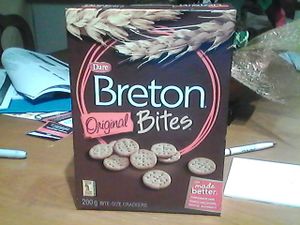 |
I choose these crackers because I eat them as a snack regularly; I often pack them in my lunches. They are small in size so they make a good snack, and are easy to carry around. I also like the taste. | 1. The box says that the cracker are made from mostly wheat flour, how does the flour go from a powder to a solid object?
This is done through the process of cooking. The crackers are made in to a paste by mixing the ground wheat with water. A paste is made and then it shaped it individual crackers. Afterwards the paste baked in the oven causing the water to be evaporated producing a solid cracker. Source: Lesson 2 ,Lesson 8 2. Why do they go stale when exposed to air? Unlike bread going stale, when water leaves the bread causing retrogression, These cracker go stale because they absorb water. This makes the crackers feel mushy and less crunchy. Source: Lesson 2 Source: http://www.yadachef.com/blog/11-2010/the-science-of-staling.html 3. The box lists "modified milk ingredients" as a component of these crackers. Why are milk products in wheat crackers? This was not talked about in FNH 200. This isapperently due to milk powder and other milk products being added to facilitate the baking process Aditioanlly these are added for flavour Source:https://books.google.ca/books?id=v5NwAgAAQBAJ&pg=PA192&lpg=PA192&dq=milk+products+in+crackers&source=bl&ots=gjvH0uoi6f&sig=0JN3fSxusA5u4DS8mABkryOryuY&hl=en&sa=X&ved=0ahUKEwiC37Pa2JHMAhUQ92MKHdS7Bt4Q6AEIPjAG#v=onepage&q=milk%20products%20in%20crackers&f=false 4. What makes the surface of the cracker rough? This was not discussed in the class. Though this is likely the result of the baking the crackers. This causes Harding due the water leaving the cracker during baking. This leaves behind only solid molecules, making the surface hard. Source: Lesson 2 5. I feel and see tiny salt crystals on the cracker, how come they don't fall off? This was not talked about in FNH 200. But this is likely the result of salt crystals being incorporated into the wheat paste during cooking. When the paste hardes during cooking the salt crystals are held in place, causing them to not fall off. |
| Cayla Boycott | 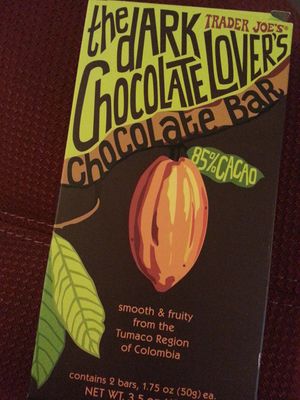 |
Dark chocolate is probably one of the few confections I eat almost everyday. It contains a mild amount of caffeine and theobromine that helps keeps my energy levels where I want them. | 1. What causes the chocolate's aroma?
The combination of the many volatile and fat soluble substances in chocolate interact with the aroma receptors in the olfactory region of the nasal passage in order to display the chocolate's aroma. 2. What causes the chocolate to melt in your mouth? A: The fat content in chocolate (ie cocoa butter) is responsible for the melting in the mouth since fat has a functional property of softening with increased temperature.\ 3. Soy lecithin is added in many chocolate bars. What is it for? Soy lecithin is a phospholipid and a naturally occurring emulsifier found in soybean oil. The soy lecithin is added in the chocolate in order to emulsify any water content and fat content of the chocolate bar and prevent the dispersed oil droplets or water droplets from coalescing together. 4. How are all chocolate bars (of a particular brand) produced with equal nutritional content? A: The reason I asked this question is that nutritional content (eg. calcium, iron, fibre) may differ depending on each cocoa plant. According to the U.S's FDA regulation of nutrition labeling, the product must be equal to a certain percentage of nutrient that is on the label in laboratory analysis. The percentage that must be met is dependent on the class of the nutrient according to the FDA. Referenced from: http://www.fda.gov/Food/GuidanceRegulation/GuidanceDocumentsRegulatoryInformation/LabelingNutrition/ucm063113.htm 5. What makes chocolate safe for shelf storage? Dark chocolate has very low water activity because it is mostly made up of fat (no moisture) and often contains sugar which binds water so that spoilage causing microorganisms can not grow easily on it. The cocoa butter is mostly made of saturated fats so it is more resistant to oxidation and rancidity. Chocolate is also packaged and stored in a way to minimize light and heat exposure that could cause rancidity of the fat in chocolate such as in aluminum foil, paper, plastic. |
| Alexandria Baugh | (picture) | I love salt and vinegar chips; they’re the only snack I have on a very regular basis | 1. What is the actual nutritional content of the chips?
2. What additives are in the chips in order to preserve them for such a long shelf life? 3. How do they keep the flavouring so strong for such a long period of time? 4. Where do the potatoes used to make these chips come from? 5. Is the flavouring from natural ingredients? |
| Alisha Burthcett | 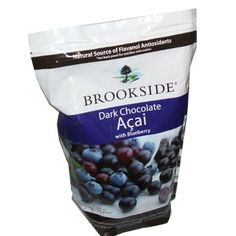 |
This is a food that I love to eat as a snack and is an easy food to take to school or work. |
1) What ingredients do they put in the chocolate to make it not melt easily? 2)What do they have to do to prepare the blueberries to prep them to be covered in chocolate? 3) What makes the chocolate cling onto the blueberry to dry? 4) How long do the chocolate covered blueberries last? 5) What does the processes of drying the blueberries do to preserve the length of freshness of the chocolate covered blueberries? 1) I would say that its not so much an ingredients added but the way in which they temper and cool the chocolate to make it keep from melting easily although in LESSON 02 it talks about lecithin that works as an emulsifier and stabilizer, which are used in chocolate to make the creamy smooth flavor, which holds it shape but melts in your mouth. 2) I would say that since these are dried blueberries inside that they would prep the blueberries by possibly tray drying/ air drying(Lesson 8) them to prepare them to be covered with the separately prepared chocolate. 3) I am assuming since the chocolate dries onto the blueberries and that they are surrounded by the chocolate that they would cling naturally to the blueberries as the chocolate dries and solidifies around them. 4) They can last longer than fresh or homemade dried blueberries since those only last 2-3 days but since they are manufactured and sealed and processed my guess is that they have a sufficient shelf life because of their drying techniques used on them and packaging. 5) Drying preserves the length of freshness by removing much of the water contents in the foods microbial, chemical and enzymatic reactions those growths decrease (lesson 8). So having these blueberries dried it increases there shelf life. |
Family Names that Start with 'C'
| Your Wiki ID | Photo of the Food | Option A: What happened? Option B: Why Did You Select This Food? |
Questions You Have |
|---|---|---|---|
| Jamie Chan | chicken wings  |
I chose this food because I love eating chicken wings and my mom only makes this when she comes early from work. | 1. How long does it take for the whole process from a live chicken to packaged meats?
This wasn't talked in class but in lesson 5 and 12, it gave me a better sense that the food needed to be processed quickly to maintain its freshness and to prevent microorganisms from growing. This article helps give general numbers of how long it takes for a live product to get to the grocery store: For meats, it's about a week. http://www.dailymail.co.uk/news/article-1370130/Just-fresh-fresh-food-supermarket.html 2. Do they use some special method of preserving the meat with gas (or something of the sort) while the manufacturers are handling with it? LESSON5 After the meat has been chopped and packaged, it can get sprayed with nitrogen to prevent oxygen-loving microorganisms from growing. 3. How do you do a check on the meat to check for parasites etc... without damaging the product? We didn't go over this in class but I'm assuming that the factory does checks via some sort of x-ray scan for the microorganisms. Maybe when I have the time, I'll read this journal article that talks about how some parasites survive and how they manage to stay hidden under the checks. van Sprang, A. P. (1984). Possibilities of survival of various parasites in meat and meat products. Tijdschrift Voor Diergeneeskunde, 109(9), 344. 4. If they do find parasites on the meat, how do they get rid of them? Do they throw it away? Since this wasn't brought up in class, I think that the most safest way the manufacturers do is by getting rid of the meat because having to do recalls/people getting poisoned, puts the company at a lot of risk. 5. What's the difference with free range and free run? I remember Judy bringing this topic up around the last couple of weeks of class but free run have an open barn and aren't trapped in cages. For free range, they have the same freedoms but also have access to roam outdoors. www.sparkseggs.com/faq/13.aspx |
| Carla Centola | 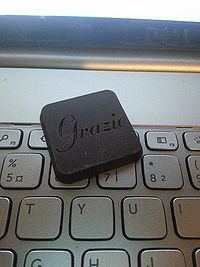
|
I have fallen in love with dark chocolate and cocoa powder for the way you can eat it pretty much where ever and when ever and with anything. It is not as sweet as milk chocolate, and actually has quite a few nutrients such as iron, making even rewarding! | 1. What is the difference between a chocolate bar that is 65% and 90%? What is the other ingredients do the remaining percentages contain?
not really something we learned but from research have determined that the percents indicate, by weight, of ingredients derived from the cocoa bean. This includes the chocolate liqueur, chocolate solids and the coca butter. When you compare two different chocolate bars with the same percent, it does not mean they will taste the same. This is because a 70% chocolate could have 50% cocoa butter, 20% solids or another bar could have 30%butter, 40% solids. Furthermore, "Unsweetened" chocolate is 85%-99% cocoa. "Bittersweet" chocolate varies from 35-84% cocoa and "Semisweet" ranges from 15% to 34%. [1] 2. How long does it take to make an average chocolate bar? first, you need to clean the cocoa beans next, roast the cocoa beans (processing) (LESSON 05,06,07). next, separate pats of the cocoa bean (for example separate the shells, butter etc) nibs are melted to create the cocoa liquor which is the coca particles suspended in coca butter(LESSON 02) blend formula and specific recipes to make a particular type of chocolate (adding milk, flavors etc) emulsifying agents added (LESSON 02) (we also commonly see lecithin added into chocolate which is a type of phosphate (or phosphatidyl choline) (LESSON 02) finally passed through a heating and cooling process (again a preservation) (LESSON 05,06,07) and packaged [2] 3. What are the preservatives added into chocolate to allow a shelf life of a quite long period of time? lecithin, and mostly fat stabilizers and emulsifiers (can promote emulsions (LESSON 02)) lecithin is a common emulsifier found naturally in egg yolks and soybean oil and is used a lot in chocolate (and other fat foods) in foods to assist with emulsions and make sure that for example the cocoa solids do not break apart from the coca liquor. It allows us to taste the creamy texture of the fat in chocolate and allows the creamy smooth flavor to stay. 4. Are the nutrients in dark chocolate susceptible to any destruction by being kept in light or in the air? Is there a optimal storage for chocolate to retain the most nutrients? Yes. Fat is very susceptible to light/heat/oxidation. This is why we commonly find chocolate and fat foods (think potato chips) in packages that will prevent the light from getting in. For example. most of the time our chocolate bar wrappers will not be in a clear container. Something that can prevent this light/ heat oxidation is keeping chocolate out of light (keep it in its package, aluminum can work) and keeping it in a cool, dark place (such as a cupboard or a pantry). (LESSON 02) 5. What are the differences in procedure of producing milk chocolate, white chocolate and dark chocolate? Does one procedure require a lot more time or money? As we saw in the processing of chocolate above, there is a step when the additives, such as milk, nuts, seeds etc are added. It would cost a little more because there are more ingredients involved but overall it may work out to the same price, depending on the amount of cocoa used. For example, often times milk chocolate will have milk, but less cocoa solids, cocoa beans etc. So although manufactures are paying more to add milk, they are paying less because less cocoa beans (which can be pricey). |
| Miriam Chen | Peach-Passion fruit Yogurt
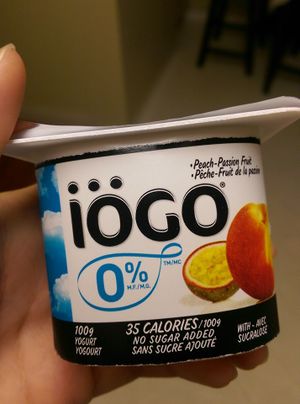 |
I never liked drinking milk growing up so yogurt acts a substitution for milk products | 1. Does adding sucralose changes the preservation period of the yogurt? Sucralose is a sweetener which can withstand wide range of temperature and storage conditions (L4). Its functional property is to sweeten the food without adding any/or low calorie. There is no direct answer from the course note, but I am going to assume that the sole purpose of sucralose in yogurt is for the function of sweetening but for preservation. 2. Is it possible to make lactose free yogurt, if so, how is the processing different from normal yogurt? Yes it is possible to have lactose free yogurt, and it is made from lactose free milk. As we learned in L2, lactose free milk could be made by adding lactase - an enzyme that lactose-intolerant people lack. Lactase can further break down lactose into galactose and glucose. 3. Is there a purpose of choosing the packaging of yogurt and how does the different packaging affects preservation? As we learned in our lessons regarding preservation methods, either freezing, sterilization, or dehydration, packaging matters depending on the method of preservation used. In this case - yogurt needs to be put in the fridge even after its processing - this is for minimizing the possibility of spoilage. 4. When do they add fruit flavours throughout the process of making yogurt? General steps for making a yogurt: milk is fermented using lactic bacteria as starter culture --> the bacteria is added into pasteurized milk and set the right conditions for best bacteria growth --> bacteria then convert lactose into lactic acid which thickens milk --> flavour then can be added This was found on this website: https://www.dairygoodness.ca/yogurt/how-yogurt-is-made 5. How and where is the "fruit flavour" extracted (if it's not made from real fruits)? This question cannot be answered without a specific brand - since flavours are extracted from different sources for different companies. Most of the 'flavours' came from concentrated fruit juice. Flavours could also come from additive such as natural flavouring as we seen on the package. However, there is no way of determining what these natural flavouring contains.
|
| Michelle Chan | Pesto Sauce
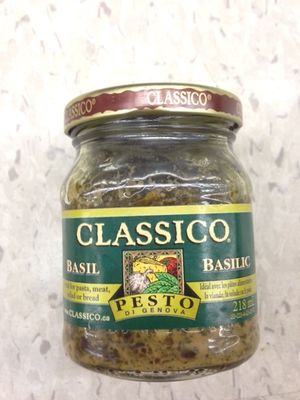 |
I had an allergic reaction to the pine nuts contained in pesto sauce when I was 14 years old. My tongue immediately began to itch and my lips started to swell. Later symptoms included vomiting and abdominal pains. Anti-histamines were taken to alleviate the swelling. | 1. Why do some bodies reject certain foods, such as pine nuts?
For peanuts, people experience allergic reactions because their bodies can't digest the enzymes (Lesson 12). So I suppose the same thing happens for pine nuts. 2. When are symptoms severe enough that an EpiPen is required? We didn't discuss severity too much, but I suppose only when anaphylactic shock occurs that one would need an EpiPen because the symptoms would be very serious. 3. What medicine can be taken to reduce the abdominal discomfort? As for abdominal pain, I don't think there is any thing to do but wait it out. Because anti-histamines are used to decrease swelling in other allergens such as scrombroid poisoning (Lesson 12), but we didn't say much about the treatments for gastrointestinal pain. 4. If someone is allergic to pine nuts are they allergic to all tree nuts? According to http://allergicliving.com/2014/09/11/can-you-be-allergic-to-just-one-type-of-tree-nut/, a person doesn't have to be allergic to all tree nuts. 5. Can allergies just occur randomly? Yes! Developing allergies can occur at any age, it just takes your body to mistakenly identify it as a threat (http://www.everydayhealth.com/allergy/when-allergies-develop-suddenly.aspx). |
| Angus Cheng | Apple
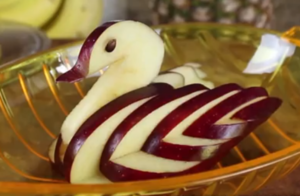 |
My friend had an allergic reaction to an apple which she found out from the doctor. Her mouth swells when eating an apple and other fresh fruits. It happened when she was in grade 5 at home. To prevent this from happening she stopped eating fresh fruits. | What kind of enzymes would contribute to this allergy? How come did she suddenly get allergic? |
| Meghan Cheung | Nutella
Insert a picture here, see example from the person (Angus Cheng) above you... You also need to take a photo and upload it (see left panel) first |
I chose Nutella because despite it is something I guiltily eat almost everyday; in nice cream, on toast, by itself, etc. I fool myself into thinking it is good for me due to the 'no preservatives or artificial flavours' as well as it being a source (small source) of protein, fibre, calcium and iron. |
1) If it has no preservatives, how come it does not need to be refrigerated after opening it? It is possible that during processing, the factory removes the natural nutrients and then replaces them with lab made nutrients and microorganisms in order to make it resilient to external factors such as oxygen, temperature, light (lesson 11). 2) Due to hazelnut shortages, how will food chemists keep the hazelnut flavour if they do go extinct? The hazelnut flavour may be able to be replicated chemically in order to maintain the flavour but I would have to look at outside sources to see if any efforts are being put in by companies to maintain a sustainable resource of hazelnuts. 3) Would they be able to keep the gooey consistency of Nutella if they removed the milk and soy products from it? In order to maintain the gel colloy feel of Nutella they use milk and soy because the proteins in it act as natural emulsifiers. If they wanted to remove soy or milk they would need to find a polysaccharide that could keep the consistency or find another way to mix hydrophilic/ hydrophobic and amino acids to keep the extreme thickness of the Nutella (lesson 6). 4) As families become more concerned with their children getting a proper amount of vitamins and nutrients, how can Nutella add them to their recipe without jeopardizing the familiar taste? After taking this course I assume that Nutella already has many vitamins and nutrients added to their recipe. 5) Does the hazelnut flavour come from ground up hazelnuts in the Nutella or is it a chemical breakdown of the taste? I assume that while the flavour originally came from ground up hazelnuts, the smooth mouth feel makes it seem like the flavour is now based on chemical mixtures. However in order to actually figure this out I would probably have to look more in depth at the ingredients or put in an inquiry with their company. |
Family Names that Start with 'D'
| Your Wiki ID | Photo of the Food | Option A: What happened? Option B: Why Did You Select This Food? |
Questions You Have |
|---|---|---|---|
| Samantha Davis |
 |
I chose wine because like wine and drink it and would like to know more about the things that aren't required to be on the label. | 1) What is not required to be on the label?
2) What negative health effects are there from preservatives? 3) What level of sugars are in wine? 4) Why do some people have allergies to tannins while others don't? 5) How long will refrigeration increase the shelf life of an open bottle of wine? Answers: 1) In lesson 4, we learned about what is required to be on food labels. In a link to the Canadian labeling requirements websites, it shows that alcoholic beverages have different labeling requirements than food. For example, food must state the nutritional values on their labels, whereas the calories and other nutritional information for wine does not have to be on the bottle. 2) Also in lesson 4, we learned that some preservatives, like nitrates, can be carcinogenic. However, in this lesson we learned that nitrates are heavily present in our saliva and it is still unclear how big of a risk they actually present to our health. 3) Though we didn't go over this in class, we did talk about sugar substitutes in Lesson 3. Some "low-calorie" alcohols may use sweeteners like aspartame to keep sugar levels high, without adding more calories. To find out sugar levels in wine specifically, I would probably look to a wine science journal. 4) Because tannins are not toxic, we didn't cover them in Lesson 12. However, I think I could look to some research on allergies or perhaps the Public Health Agency of Canada website to answer this question. I would suspect the answer to this question might be that some people possess enzymes that are able to break down tannins into digestible components, whereas others might have a gene that limits the production of this enzyme and therefore aren't able to break down tannins effectively, resulting in a slight allergy. 5) In Lesson 7, we learned that refrigeration can slow down food spoiling bacteria to increase shelf like by days or even a week. However, because some bacteria are able to survive even freezing temperatures, it would be very unlikely to prevent microbial growth in wine after the bottle has been opened for several weeks. |
| Bethany Del Begio |
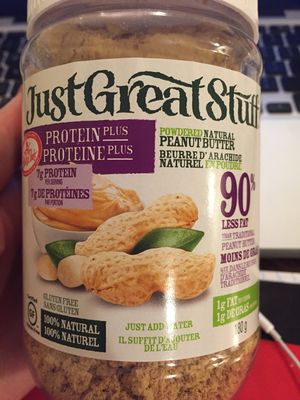 |
I chose peanut butter powder because it is a food item I recently incorporated into my diet. I don't know much about how it is made and processed and have been curious to find out more as it is a relatively new product in grocery stores. | 1) How is the oil removed from the peanuts?
I think the oil is most likely removed through a high heat processing method in order to extract the oil from the peanuts. (Lesson 6) 2) How are the remains processed into such a fine powder? My guess for how the remainders of the peanuts are processed once the oil has been extracted is that they are milled in a machine until they are broken up very finely and then possibly put in water and sent through a spray drying process leaving the final product as a fine powder. (Lesson 8)
4) Does powdered peanut butter still have the same allergen risks as normal peanut butter? Yes, the powdered peanut butter has the same allergen risks as normal peanut butter because although the oil has been removed from the product, it still contains the peanut protein. The label also states there is an allergen risk for peanuts and tree nuts in the product. (Lesson 2 – Allergens) 5) As powdered peanut butter does not require refrigeration, how long is its shelf life? The product label has a best before date of May 2017, which is approximately two years from the time the peanut butter was purchased meaning it is a shelf stable product. The reason it is shelf stable is because it has essentially been dehydrated creating a difficult (low water activity) environment for microorganisms to grow in as there is no water available for chemical and biochemical reactions. (Lesson 5) |
| Alysha Deslippe |
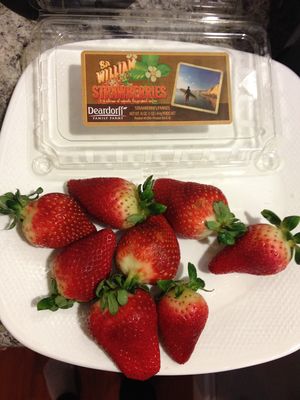 |
I chose strawberries because they not only taste great but they are also good for you. Strawberries can be eaten with a meal, like in a smoothie or on their own as a snack. My personal favorite is strawberries on oatmeal for breakfast. | 1) How are the strawberries cleaned after they are picked? After they are picked the strawberries are likely passed through mist or water to get any dirt or large residue off. We did not explicitly talk about how produce is cleaned after it is picked, but I intend to look into it further by reading the following website http://www.circlesfarm.com/strawberrytips.html. 2) On average how many strawberries are in one container? The amount of strawberries present within a container depends on weight. Manufacturers are required to state the net weight of a strawberry carton on the labelling. As a result of this, there isn't a set number of strawberries per container. The number of actual berries will be somewhat influenced by the size, big berries means fewer in number to achieve the same weight in smaller berries. (Lesson 4: Food Standards, Regulations and Guides) 3) What type of pesticides are used to prevent any bugs from entering into the strawberries? While we did not go into any specific pesticides in this course, this question would be largely influenced by farming technique. A conventional farm may use multiply pesticides or herbicides on the strawberries to ensure their product where as an organic farm would use none. In Canada, herbicide or pesticide residue is not considered an additive and does not need to be declared on a food label. (Lesson 4: Food Standards, Regulations and Guide) I will read more about the specific pesticides on the government of Canada website later on to learn more. (http://publications.gc.ca/site/archivee-archived.html?url=http://publications.gc.ca/collections/collection_2009/agr/A118-10-17-2005E.pdf) 4) What temperature are the strawberries kept at during transportation to ensure that they don't spoil? As strawberries are a perishable food item they are stored in the refrigerator to help with preservation. (Lesson 7: Preservation of Foods By Low Temperature) This works well for short term storage such as in a grocery store or house, however, during long transportation it might not be enough. Controlled atmosphere techniques that place the cartons of berries within an enclosed space where the oxygen, nitrogen and carbon dioxide are varied may better preserve the produce over long time periods. (Lesson 7: Preservation of Foods by Low Temperatures) The exact temperature they are stored at will depend on the atmosphere the berries are exposed to. 5)How long can a container of strawberries be kept in storage for at a grocery store? The length of time that the strawberries can be preserved before they start to develop mold or other micro organisms largely depends on the processing and storage conditions. For example, if the strawberries are stored at room temperature on a shelf they would last a few days at best. This is very different then if the berries were to be stored under cool temperatures or even in a controlled atmosphere. (Lesson 7: Preservation of Foods by Low Temperature) Processing techniques such as freeze drying or dehydration also significantly increase the storage life of the strawberries. If these techniques are used, the berries can remain on a grocery store shelf for months. (Lesson 8: Dehydration as a Preservation Method, Lesson, Lesson 7: Preservation of Foods By Low Temperature) Finally, the types of microorganisms that can grow on the strawberries will depend on factors such as temperature of the environment or water activity within the berries. Different micro organisms may be able to develop on the berries during transport where as others may be able to develop during storage. (Lesson 5: Rational for Food Preservation) As a result, storage and processing conditions need to be properly maintained from the moment the berries are picked till they are ready to be consumed in order to maximize their shelf life. This length of time will vary based on storage techniques used. |
| Evan Duxbury | 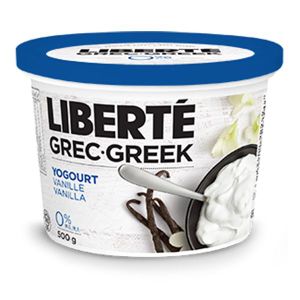 |
I use yogurt in my cereal and as a replacement for things like mayonnaise and sour cream | 1) How does one make yogurt? 2) For which parts of the population is fat free a better choice than regular? 3) How quickly must yogurt be sold from the time it's produced before it's considered waste? 4) Since yogurt contains fat, sugar and protein, how long can somebody survive on a diet of only yogurt? 5) Why doesn't yogurt stir as nicely into a sauce as sour cream?
1) We learned in class that yogurt is made via the fermentation of milk using lactic acid bacteria and that yogurt is a more stable form of the low acid milk (lesson 9). Yogurt recipes are easy to find on sites like BCdairy.ca and typically involve mixing milk with a source of bacteria, like the previous batch of yogurt. 2) We did not discuss nutrition in this course. However, we did learn that fats deliver 9kCal/gram. So, anybody looking to reduce their caloric intake would want to choose the fat free option (lesson 2). 3) Even if yogurt is stored under refrigeration (with or without vacuum packaging) to delay the growth of the acid-tolerant psychrotrophic yeasts and moulds, it is still considered a perishable product like milk, and so must have a durable life date on its packaging (lesson 6 & 9). For more specific timelines until spoilage, one could check consumer safety resources. 4) We did not discuss this question in class, but apparently if you had to eat only one type of food, yogurt is a good choice. http://www.livescience.com/33687-food.html (it was difficult to find scholarly sources as funding for hypothetical situations like these is likely hard to come by). However, yogurt does not contain vitamin C so you’d develop scurvy after 8 months which would soon kill you. 5) We learned that fats lend a softening property to food (lesson 2). Since sour cream has more fat, it follows that it would melt more easily into sauces. |
| Chantel Dong | 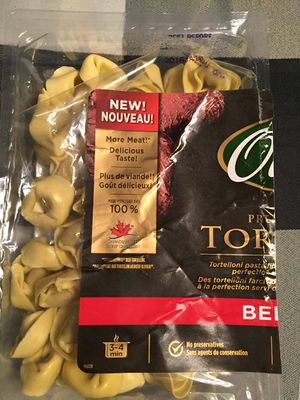 |
Tortellini is one of my favourite pastas, I remember eating the tri-coloured cheese version a lot when I was younger. However the last few times I ate this beef filled tortellini. | 1)Often times I freeze the fresh package of tortellini: What happens during the freezing process?
Although freezing does not kill all microorganisms, it provides a longer shelf life by slowing down and preventing microbial growth. During the freezing process, the low temperatures of -12 to -14°C freeze the free water within the pasta, slowing down the chemical and enzymatic reactions. Freezing also slows down the microbial growth (lesson 7). However, since my household freezer and storage conditions are most likely not optimal, physical, chemical, and enzymatic changes may be still occurring (lesson 7).
We did not discuss the exact number values as to how long food can be kept in the freezer past the best before date. However, in lesson 7, a table listing the approximate months of freezing for some foods was provided, but not for pasta. Food past the durable life date are safe to eat, however, the appearance, flavour, and nutrition value may have declined (lesson 4). When I have time I will check http://www.fda.gov/downloads/Food/FoodborneIllnessContaminants/UCM109315.pdf to get an approximate time frame.
According to lesson 7, the type of packaging that I normally see tortellini packaged in, is called modified atmosphere packaging (MAP). This a type of controlled atmosphere packaging. MAP packaging creates different atmospheric conditions around the pasta compared to the normal atmosphere. The pasta is first placed into the package, next the air in the package is removed, then the package is either backflushed or flushed with the desired mixture of gas, and finally the package is sealed. In addition to refrigeration or freezing, MAP allows the pasta to have a longer storage life.
We never talked about the manufacturing of meat in FNH 200. I can imagine that the manufacturing of meat is a long process. When I have time, I may read more about meat manufacturing on the Food and Agriculture Organization of the United Nations website, specifically these websites: http://www.fao.org/docrep/t0562e/t0562e03.htm and http://www.fao.org/docrep/010/ai407e/ai407e04.htm
According to tortellini’s ingredient list and nutrition fact table, it includes salt. The addition of salt is one way of lowering water activity. Salt lowers the water activity by binding water to prevent it from partaking in chemical and biochemical reactions (lesson 5). Also, the low temperature of the refrigerator extends the storage life of the pasta because low temperatures decreases the rate of enzymatic, chemical and microbial reactions (lesson 5). |
| Will Dichuk | 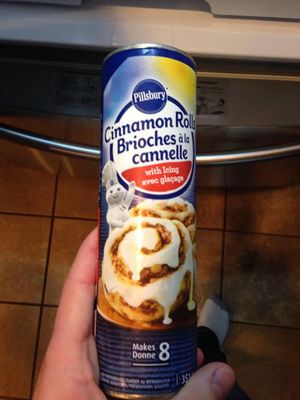 |
Cinnamon Rolls are one of my favorite breakfast foods to eat. They are quick and easy to make when in a rush to get to school. | 1) How is the expiration date for this item determined?
2) Why does this product need to be refrigerated? 3) Does the way the product is packaged extend its expiration date? 4) Why is the icing packaged separately? 5) Why is the product vacuum sealed? |
Family Names that Start with 'E'
| Your Wiki ID | Photo of the Food | Option A: What happened? Option B: Why Did You Select This Food? |
Questions You Have |
|---|---|---|---|
| Your Name | Photo and Caption | Why You Chose this Food? | Your Questions |
| Your Name | Photo and Caption | Why You Chose this Food? | Your Questions |
| Your Name | Photo and Caption | Why You Chose this Food? | Your Questions |
Family Names that Start with 'F'
| Your Wiki ID | Photo of the Food | Option A: What happened? Option B: Why Did You Select This Food? |
Questions You Have |
|---|---|---|---|
| Isabela Fuster Rau | 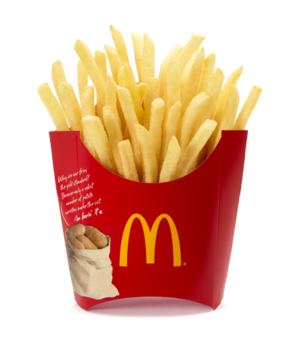 |
I chose McDonald's french fries because it's something that is consumed worldwide and especially popular in North America. | 1. Why they are different from all the other french fries we can buy or prepare?
2. How do they always taste the same? 3. How many steps are needed to the final result? 4. How many ingredients do they have? 5. How much does it cost for McDonald's to produce a medium portion of french fries? |
| Elaine Fung | 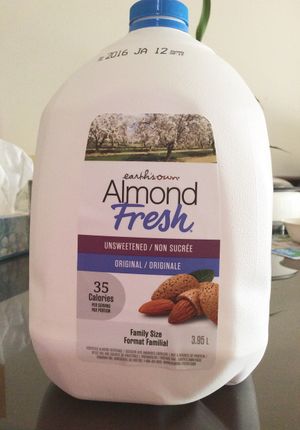 |
I chose this food because I drink almond milk almost every day. I also incorporate it into oatmeal and smoothies because I prefer the nutty flavour it gives rather than cow's milk. | 1. How were the almonds processed to produce the beverage?
2. How are Vitamin D and Vitamin B12 added, and where did they originate from? (as it is a fortified beverage) 3. Were the jug containers stored in a controlled environment during transportation to the grocery store? 4. Why are some almond milk beverages packaged in cartons and some in plastic milk jugs? 5. Was this beverage pasteurized? (it was not labelled on the packaging)
2. Vitamins are added due to the loss during thermal heat processing (Lesson 11 Processing on Nutritive Values of Food). I could not find where Vitamin D and Vitamin B12 are sourced specifically for almond milk. However, Vitamin B12 is usually from non-animal sources for fortified products. Vitamin D is usually manufactured by UV irradiation of ergosterol in yeast or 7-dehydrocholesterol from lanolin. I assume that the UV irradiation functions as both a disinfection method and Vitamin D production method. (Lesson 10 Preservation with Ionizing Energy) Sources: https://www.nlm.nih.gov/medlineplus/ency/article/002403.htm https://ods.od.nih.gov/factsheets/VitaminD-HealthProfessional/#h3 3. There is no specific information on the controlled environment during transportation for almond milk; however, from Lesson 1 we learned that controlled atmosphere of food products is essential for extending the storage life. An almond milk company (Almond Breeze) says that unopened almond milk should be stored at 35-45°F. I would guess that the transportation environment should also be between this temperature range. Sources: https://www.almondbreeze.com/faq/storage-and-usage/ 4. Paper cartons and plastic milk jugs serve different purposes. Paper cartons are used for shelf-stable almond milk where the almond milk can be stored without refrigeration. The paper cartons are made out of paperboards for stiffness, polyethylene for a tight seal, and aluminum provides a barrier against oxygen and light. Plastic milk jugs on the other hand, are used for refrigerated almond milk (Lesson 6 Material Used for Packaging Thermally Processed Foods).These jugs are usually white in colour to prevent some incoming light. The container is multi-layered that acts as an oxygen barrier for extended shelf life. Almond milk is a fortified beverage with high amounts of added vitamins that are sensitive to oxygen and light, therefore, packaging with an oxygen and light barrier is crucial to prevent oxidation and destabilization. (Lesson 11 Effects of Processing on Nutritive Values of Foods) Sources: https://www.almondbreeze.com/faq/about-our-packaging/ Newsome, 1986: "Effects of food processing on nutritive values". (A scientific status summary). Food Technology, 40(12): 109-116. 5. Almond milk is pasteurized. Specifically, HTST (high temperature, short time) is used to eliminate all pathogens such as pathogenic bacteria and viruses. (Lesson 6 Thermal Processing) Sources: https://www.almondbreeze.com/faq/making-almond-breeze/
|
| Sabrina Feng | 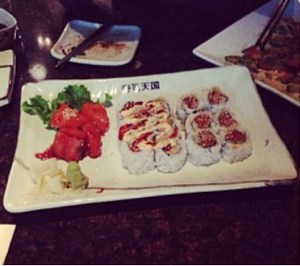 |
There were numerous of occasions where my friends would get really sick after eating sushi. They were nauseous and threw up quite a few times. After a day or two, the sickness went away and they recovered. | 1. Why is raw fish a likely trigger for food poisoning?
2. If I were to eat this meal with them, would I get sick as well? Or is this response dependent on each individual person? 3. Are there any parts of the fish that cannot be eaten due to safety concerns? 4. What type of processing does the fish have to go through before it can be served? 5. What are the different ways these fish can be raised? Which one is the most efficient? Q1. Raw fish may contain an organism called Norwalk virus (lesson 12) which leads to symptoms like vomiting, diarrhea, headache and fever. This virus can be killed through cooking and pasteurization (lesson 12) but since some sushi rolls use raw fish, cooking/pasteurization will change the texture of the fish which changes the product entirely. Q2. According to the Health Canada website, there are ~300 to ~400 outbreaks of Norwalk virus each year. An outbreak is when 2 or more people have similar illness after the ingestion of the same food (lesson 12). I think with this statistic, it can be assumed that if I ate the same food as my friend who got sick from this microorganism, I would be sick too. Q3. Although we didn’t talk about this in class, I think that there is no part of the fish that is unsafe to eat if proper pasteurization/sterilization methods are used because using enough heat can kill the ‘ugly’ microorganisms (lesson 6). Q4. Through my experience of eating raw fish, I believe that no heat is applied for preservation methods. Instead, freezing/refrigeration is used to preserve the fish. Norwalk virus can be prevented by storing foods at under 4 degrees Celcius (lesson 12) thus refrigeration can be a good technique especially because it will not impact the quality of the food like freezing can with its ice crystals (lesson 7). Q5. We did not talk about the farming of foods in FNH 200 however, there is an article in National Geographic Magazine called “How to Farm a Better Fish” by Joel K. Bourne, Jr.
|
| Michelle Fan | 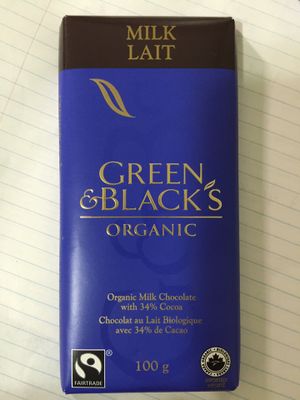 |
I chose chocolate because it is my guilty pleasure and it is something that I tend to overconsume in one sitting. Also, I chose organic over regular chocolate bars because organic chocolate bars tend to contain more pure and real ingredients. | 1. How is chocolate made from cocoa beans?
2. Why do manufacturers make chocolate bars in a rectangular shape? 3. Does the process of chocolate making include refrigeration for a certain period of time? 4. How do manufacturers stamp their brand names on their chocolate products? 5. How is milk solid mixed with chocolate so that the chocolate bars would not show a separation of the two? Answers: 1. The cacao beans are to be placed in a rotating oven and roasted at 210-290 Fahrenheit for about half an hour to two hours to give its unique flavor and aroma. I think this browning process is also known as the Maillard reaction. (Lesson 2) The inner parts of the roasted cacao beans are the parts that are used in chocolate. Source: http://facts-about-chocolate.com/how-is-chocolate-made/ 2. I assume that the rectangular shaped chocolate is chosen because it is more palatable than a circular shaped chocolate. (Lesson 3) Also, It is easier to crack small pieces from a large bar if the bar is a rectangular shape. 3. The process of chocolate making does include require refrigeration. However, during the manufacturing process, the chocolate is cooled to about 27 degree Celsius before it undergoes heating again. Sources: https://en.wikipedia.org/wiki/Chocolate#Processing 4. I think manufacturers stamp their brand names on their chocolate products while they are still on their conveyor belt waiting to be cooled. 5. I guess some form of emulsifier must have added to chocolate to prevent separation of the ingredients. (Lesson 2) |
| Meghan Fenton | 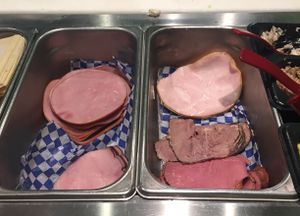 |
I chose sandwich meat because I have a few friends that experienced nausea and diarrhea after consuming sandwich meat from the dining hall. There symptoms lasted no longer than two days. They only experienced this once, it is not a regular occurrence when they consume the meat so it can be assumed that they experienced food poisoning. | 1. What processing does sandwich meat undergo before serving?
2. How do you kill the staphylococcus aureus that is present in some sandwich meats? 3. Is SFP only common in spoiled meats? 4. How do sandwich meats become exposed and contaminated by SFP? Assignment 3 Answers: 1. To process meats, nitrites are added to prevent the growth of Clostridium botulinum also to create the colour of the meat (lesson 4). The meats are cooked, packaged, then refrigerated so that they are ready to eat upon opening. 2. Staphylococcus aureus can be killed via cooking and pasteurization. Most bacteria are killed at temperatures ranging from 82 degrees Celsius to 93 degrees Celsius (lesson 5). Pasteurization inactivates pathogenic bacteria from the meat by exposing the food to high temperatures for about 15 seconds, prior to packaging (lesson 6). However, if the sandwich meat has already been exposed and infected by SFP it is recommended to throw away the food as it can cause food poisoning. Even if the bacteria has been killed, the toxins can still produce illness (lesson12). 3. SFP can be found in various products that have been exposed to the bacteria such as dairy products, pudding, cold salads, cream filled pastries etc. The bacteria has a high tolerance to salt and can therefor inhibit deli meats (Healthline.com). 4. Some sandwich meats that were not stored properly such that they were not refrigerated, could experience an increase in microbial growth since the cool storage temperature decreases the microbial growth rates (lesson 5). It is common for the meat to be contaminated with SFP by the food handler or from the equipment and surfaces that the food comes into contact with (FoodSafety.gov). |
| Peter Foucher | 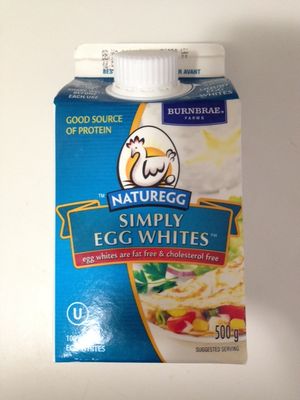 |
I eat egg almost daily and I always use Egg Whites for additional protein | 1. How are the eggs separated from the yolks?
2. What do they do with the separated yolks? 3. How are the egg white preserved to have such a long shelf life? 4. Is there any loss of nutrition when using egg white substitutes vs 'the real deal'? 5. Are there any concerns with eating egg white substitutes raw? 1-Before pasteurization, the eggs are separated during processing by machine and used in separate applications. 2-The yolks is packaged and sold separately to Foodservice and Food Ingredient customers for use in other manufactured foods. (Eg. Mayo, salad dressing, baked products)* 3-Pasteurization – A thermal process using temperatures at least 72°C for 15 seconds (HTST – high temperature short time) OR (ESL – Extended Shelf Life) as required by the Canadian Food Inspection Agency. The eggs are heated at a temperature and for a sufficient amount of time to destroy all pathogenic types of micoorganisms. 4-As long as the contents of the liquid egg whites are 100% egg whites, then the nutritional value will be approximately the same. The pasteurization process does not denature the Avidin protein, therefore keeping the Biotin bound and bioavailable.* 5-Egg whites, like raw eggs, could contain traces of Salmonella although the pasteurization process will likely have killed off this and many other bacteria and Salmonella testing is required before consumer sale – therefore pasteurized liquid egg whites could be considered safer to consume raw than traditional eggs. |
Family Names that Start with 'G'
Family Names that Start with 'H'
| Your Wiki ID | Photo of the Food | Option A: What happened? Option B: Why Did You Select This Food? |
Questions You Have | |
|---|---|---|---|---|
| Kentaro Hayashi | 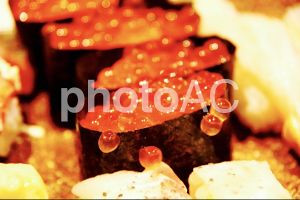 |
What Happend?
I was affected by the reaction when I was 8 year old in a sushi restaurant back in Japan. The symptoms were an itchy feeling in my throat and my neck, watery/ itchy eyes, vomiting and difficulty breathing. My symptoms calmed down after I threw up the food I was eating. We did not call the ambulance because the reaction wasn’t too violent. I only had a small amount of it so it wasn’t too life threatening. |
Your Questions
Couple of weeks ago, I had a small amount of salmon roe and I was mostly fine, with only a little itchiness in my eyes. It puzzles me how I can slowly grow out of my allergies. My question would be what exactly is in salmon roe that cause my reaction, because I am fine with other fish eggs. Answer: I cannot answer what exactly in the salmon roe that caused my allergic reaction but from lesson 12, I found out that there are different sensitivity levels of toxicity. Possibly there is a toxin that is relatively higher dosage in salmon roe but quite low in other fish eggs that caused my reactions. Also, I may be less sensitive now to whatever toxin it is that I am sensitive, so with the dose response curve, I am in the "no effect" part. | |
| Nora Hong | 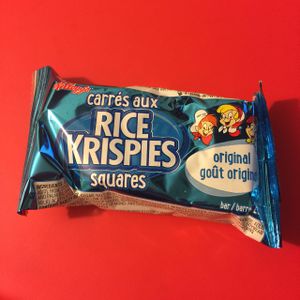 |
Why You Chose this Food?
This is the food that I will eat when I'm studying and it's right beside my table. |
Your Questions
1. How many days can I keep it after its expiration date? The Rice Krispies have a shelf life of 6 months or more and will still be good for a month after its expiration date. 2. Won't plastic package do harm to our health to some extent? There are two toxic chemicals that are contained in the plastic packages. Two chemicals are BPA and DEHP. Plastic wrappers, food cans and storage tubs could deposit at least two potentially harmful chemicals into our food. Bisphenol A, or BPA, and a phthalate called DEHP, are known to disrupt hormonal systems in the bodies of both animals and people which will lead to developmental and reproductive problems. Also, these two chemicals might trigger heart disease, cancers and brain disorders as well. BPA and DEHP both appear in various food packaging materials. 3. Is it completely clean with the food inside the package? Depending on the methods that used for sterilization, the sanitation of foods may vary. Unfortunately, I did not find out the method that Rice Krispies used for sterilization. Therefore, I have assumed 3 methods of sterilization for this product. Considering the plastic packaging of the Rice Krispies, the combination of Ultra-High Temperature Processing (UHT) and Aseptic packaging have the highest possibility to be used for sterilization (which is also another form of commercial sterilization). The UHT-Aseptic process involves using ultra high temperature (direct injection of steam of 140-150。C) to apply on food before packaging and fill the food into pre-sterilized containers. This process leads to a higher quality product which can be stored in the room temperature and it is considered to be clean. For Pasteurization, pathogenic(disease-causing) bacteria and viruses would be inactivated. However, these bacteria and viruses are not being killed. So, it is not completely clean in this case. For commercial sterilization, only microorganisms that will cause spoilage and disease will be killed. Small numbers of thermophilic bacteria spores may survive after the commercial sterilization; however, the spores cannot germinate and produce actively growing cells at room temperature. 4. How do people make Rice Krispies? Recipes from the website of Rice Krispies: http://www.ricekrispies.com/recipes/the-original-treats Citation from the website: INGREDIENTS: 3 tablespoons butter 1 package (10 oz., about 40) JET-PUFFED Marshmallows OR 4 cups JET-PUFFED Miniature Marshmallows 6 cups Kellogg's Rice Krispies cereal DIRECTIONS 1. In large saucepan melt butter over low heat. Add marshmallows and stir until completely melted. Remove from heat. 2. Add KELLOGG'S RICE KRISPIES cereal. Stir until well coated. 3. Using buttered spatula or wax paper evenly press mixture into 13 x 9 x 2-inch pan coated with cooking spray. Cool. Cut into 2-inch squares. Best if served the same day. MICROWAVE DIRECTIONS In microwave-safe bowl heat butter and marshmallows on HIGH for 3 minutes, stirring after 2 minutes. Stir until smooth. Follow steps 2 and 3 above. Microwave cooking times may vary. Note -For best results, use fresh marshmallows. -1 jar (7 oz.) marshmallow creme can be substituted for marshmallows. -Diet, reduced calorie or tub margarine is not recommended. -Store no more than two days at room temperature in airtight container. -To freeze, place in layers separated by wax paper in airtight container. Freeze for up to 6 weeks. Let stand at room temperature for 15 minutes before serving. 5. What is the sugar percentage of one of this? 4g sugar per serving(per bar). 140 cal per bar. | |
| Stephanie Holbrook | 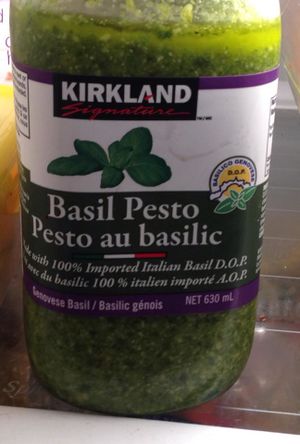 |
Why You Chose this Food?
Pesto is one of my favorite condiments for savory dishes. I use it in sandwiches of course and I am always looking for other cooking uses for it as well. |
Your Questions
1. How many processes go into making pesto? 2. What ingredient does the oil come from? 3. What exactly is in pesto other than basil? 4. What is the health value of pesto sauce? 5. Why is it so salty? | |
| Gillian Haigh | 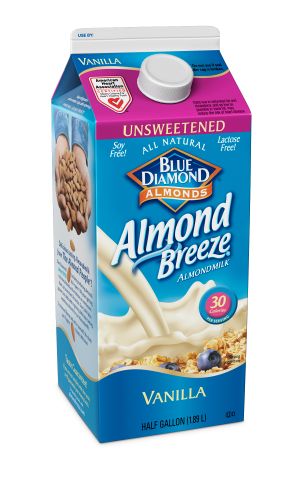 |
Why You Chose this Food?
I I drink almond milk every day and is one of the most processed foods I eat. |
Your Questions
Why is some almond milk refrigerated and some not? Some almond milk is refrigerated and some isn't likely due to the difference in processing. Usually the difference between shelf stable and refrigerated products is one of two things; either one is pasteurized while the other is commercially sterilized at ultra high temperatures (UHT), or both have been commercially sterilized but the packaging in one was in a sterile environment while the other was more open to contaminants. After looking into which of these is the case I was unable to find a reliable source, although any source I seemed to look at accounted for the difference in storage due to the differences in pasteurization vs UHT processing. Does this pasteurization change the almond milk at all? According to Silk’s website, a large producer of almond milk products, there is no change in flavour. I myself have had both refrigerated and shelf stable almond milk and have not noticed a difference, although many changes can happen to products at high temperatures such as browning reactions. Silk’s Website https://silk.com/products/unsweetened-original-almondmilk-shelf-stable 2. What are the extra ingredients in almond milk for? The three ingredients other then almonds and water are; Locust Bean Gum, Sunflower Lecithin, Gellan Gum. Locust bean gum is extracted from the beans of carob trees and is a gelling and thickening agent for the milk. Sunflower Lecithin is an emulsifier to stop the different components in the water from separating. The Lecithin is a good emulsifier because it attracts both water molecules and fatty substances keeping the mixture homogenized. Finally the Gellan Gum is a gelling agent which is a polysaccharide created by bacteria. Although a fairly new ingredient (only introduced in the 90s) its used as a replacement for agar as it can withstand higher temperatures (this supports my pasteurization and UHT theory above) and can be used in lower concentrations.
4. What happens to the Almond waste? Although again I could not find any information about industrial almond production, I found an extensive number of recipes using leftover almond pulp at home including anything from crackers, muffins, and other baked goods. I would assume similarly in an industrial setting the almond pulp would be used in other almond products 5. What happens when almond milk goes bad? Again I could not find a reliable source for this question but looking at the three different types of almond milk and generally how long they last, it gives a good indication of the cause of the spoilage at the milk. Homemade almond milk (no heat treatment) only lasts a few days in the fridge, while refrigerated almond milk (pasteurized) lasts roughly two months unopened, and shelf stable (UHT) over a year. The homemade almond milk would have no processing to kill bacteria in the milk and therefore would go bad the most quickly, the pasteurized almond milk has had most but not all the bacteria killed and therefore has a longer shelf life then the homemade almond milk, and the shelf stable almond milk is processed at UHT and is commercially sterile; i.e. there is no bacteria cause spoilage. Therefore we can assume that the bacteria is the biggest cause of spoilage. Yet the shelf stable almond milk still eventually will degrade, this can be due to oxidation, browning reactions, or other processes which happen to the milk slowly over time. | |
| Nancy Huynh | 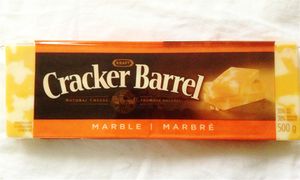 |
Why You Chose this Food?
I picked marble cheese because it is my favorite topping to add to: pasta, grilled cheese, crackers, fries, etc. Although I enjoy many types of cheese products, I often choose marble when purchasing cheese at the grocery store. |
Your Questions
1. What determines the marbling effect to the cheese?
2. What gives different types of cheese its color?
3. How much milk is required to make the different types of cheeses?
4. Is there a certain temperature cheese should be kept at to avoid spoilage?
5. How different or how similar would the process of creating cheese differ from creating lactose-free cheeses?
| |
| Clarence Han | 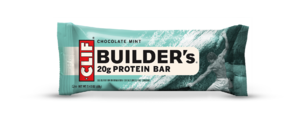 |
Why You Chose this Food?
I picked a Clif Bar because it is a nice and easy snack to eat during the day that has a good protein to calorie ratio. It often helps me hit my required macros for the day when I have not been eating as much. |
Your Questions
1. What purpose does adding sunflower oil serve in creating this protein bar? 2. Do they ever expire? I see no expiration date anywhere on the packaging 3. What is "beef juice concentrate?" 4. A listed ingredient is "natural flavors". What sort of ingredient is that? 5. It says "May contain traces of milk, peanuts, wheat, and other tree nuts." How can food manufacturers not be sure of what they are putting into our food? | |
| Yanika Hu | 
|
Why You Chose this Food?
I crazy in love with chocolate for any type. Especially, the chocolate contains with different ingredients such nuts, fruit and raisin. I enjoy the crunchy texture within the chocolate when I eat them. I always like to try some new flavors of chocolate and unique packages of chocolate. |
Your Questions
1. How to maintain the sharp of the chocolate within the packaging? 2. Why the chocolate contain sodium? and How it affect the flavors of the chocolate? 3. Why the chocolate shouldn't expose in the air when it is in the refrigerator? 4. When we melt the chocolate, why we need to use the stainless steel bowl as container and put it into the boiling water? 5. What are the difference between white,milk and dark chocolate? |
Assignment 3 Answers:
1.The outside packaging helps to maintain the sharp of the chocolate. The aluminium foil packaging can prevent light and stop oxygen get into touch with the chocolate which helps preventing the spoilage and light-affection. 2.The sodium comes from salt which is added into the chocolate. The salt not only enhances the flavor of the chocolate but also preserves the chocolate out of spoilage. 3.When the chocolate exposes in the air in the refrigerator, the cold air will dehydrate the chocolate and makes it less favorable than stays in the room temperature. 4.Since the stainless bowl is a nice heat conductor, using it to melt the chocolate is perfect equipment. If the chocolate is directly melt via the high temperature, it will dehydrate quickly and the sugar inside the chocolate will caramelize. Therefore, the taste will become bitter. It's suitable to melt the chocolate by using boiling water which it will increase the temperature genteelly and consistently. 5.The difference of the white, milk and dark chocolate is the percentage of cocoa solid. The dark chocolate contains the highest percentage cocoa solid and the white one doesn't have any cocoa solid. I will do more research on the health benefit for the different types of chocolate via the [1]. |
| James Hsin | 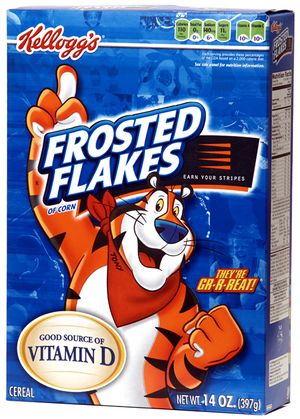 |
Why You Chose this Food?
I love frosted flakes! It's really sweet and crunchy I eat it for breakfast every day. |
Your Questions
1. How does the BHT in the packaging improve shelf life? 2. Why doesn't the sugar on the flakes melt? 3. How are the added vitamins put into the flakes? 4. How do the flakes stay crunchy? 5. How can I prevent my frosted flakes from going soggy in milk? |
Answers for Assignment #3
1. BHT is an antioxidant! It prevents the food from browning through oxidation. This way, it allows the food to stay "fresh" and have a longer shelf life. 2. Sugar on the flakes don't melt simply because a higher temperature is required to melt sugar. Often, goods are transported in a cooler dark environment, and temperatures simply aren't hot enough to melt the sugar. 3. The vitamins are often as a powder into the mixture of the cereal. Occasionally, they can be lined on the inside of the packaging, but nowadays it is mixed right into the food. 4. The flakes stay crunchy due to the nature of BHT keep the food fresh! As well, the sealed plastic bag keeps moisture out and reduces free water activity. The reason for the flakes being crunchy is because the flakes are "puffed"...there are very small air holes in the food that keep it light and crispy. 5. As for preventing frosted flakes going soggy in milk, over time, it is not possible. Eat it as fast as possible! By adding milk you increase the free water activity so...you cant permanently have crunchy flakes since you are adding water to it! |
Family Names that Start with 'I'
| Your Wiki ID | Photo of the Food | Option A: What happened? Option B: Why Did You Select This Food? |
Questions You Have |
|---|---|---|---|
| Tahne Iao | 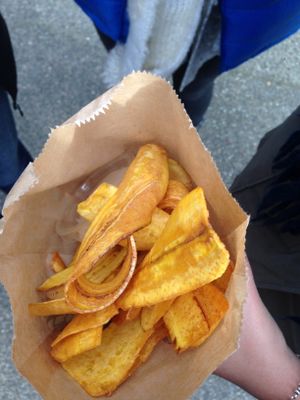 |
I love eating banana chips and always thought that it would be a healthier alternative to potato chips. | Questions:
1. Are the banana's nutritional value kept after being processed into chips? 2. Is it actually a healthier option compared to potato chips? If so, how much more healthier? 3. What makes it go stale after a while? 4. Is it better to store it in the fridge or in room temperature? (for optimum taste and quality) 5. How does the natural mushy texture turn crunchy and hard? Answers: 1. Although we want to retain as many of the nutrients as possible during food processing, we learnt that some losses in certain nutrients are inevitable. (Lesson 11) For example, most dehydration processes results in loses of certain vitamins that are sensitive to heat in the presence of oxygen. Thus certain amounts of Vitamin C in the bananas will be lost. 2. I did some research online for this question. Whether or not banana chips are healthier than potato chips really depends on how the chips are processed. If they are both processed the same way, banana (or plantain) chips may contain more vitamin A and C, and also lower in sodium than potato chips. But on the other hand, potato chips may have a higher potassium and vitamin E content. Both chips have their respective pros and cons. (Source: http://healthyeating.sfgate.com/health-benefits-eating-plantain-chips-over-potato-9883.html) 3. After some time, the banana chips will absorb some of the moisture from surrounding air. This water uptake causes the banana chips to go stale and eventually lead to deterioration. (Lesson 5) 4.The main concern with keeping chips fresh is the amount of oxygen that it is exposed to. The best way to store banana chips is to seal it tightly in a container so it is exposed to a limited amount of oxygen. Because banana chips are high in fat, oxidation of fatty acids results in rancidity. (Lesson 5) Keeping chips in the fridge may help with prolonging the taste and texture of the chips due to the lower temperature, but as long as it is sealed correctly, chips can also be kept in the cupboard. 5. The change in texture is mainly due to the change in moisture of the banana. During deep frying, the high temperature of the oil evaporates water in the banana and in turn the banana absorbs the oil, giving a low water content and high oil content. (Lesson 8) This dehydrates the banana and gives it the hard and crispy texture. |
| Vienna Ip | 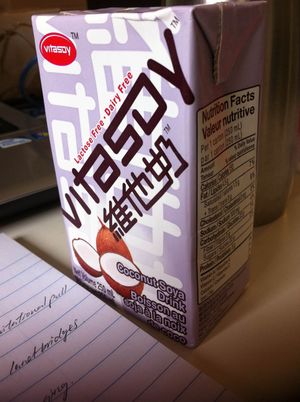 |
My brothers and I grew up drinking Vitasoy. Now that I have a chance to learn more about food and it's origins, what were we really drinking? | 1.What sorts of emulsifiers does this product have?
2. How long has the drink been sitting in its carton? 3. For a lactose-intolerant person, what different effects do soy milk, almond milk, and rice milk have on them? 4. What chemicals in this product are hard for our bodies to digest and what is their significance in this product? 5. Does ultra-high-temperature processing have an impact on the protein emulsifiers used? Answers: 1. Monoglycerides, diglycerides, carrageenan, sodium alginate, and guar gum are used in this product to stabilize and emulsify different components. Mono and diglycerides emulsify fat and water. Carrageenan, sodium alginate, and guar gum stabilize and thicken the drink to the appropriate consistency (Lesson 2). 2. The information in this course does not allow me to fully answer this question. However I have learned that the drink is safe to drink even after its best-by-date if unopened and kept in good storage conditions because it is processed over heat and sterilization and packaged in a tetra pak. In addition, the storage life of a product under ultra-high-temperature processing can be stored for at least 6 months, so an educational guess would be that this product has been sitting in its carton for a few months (Lesson 6). Good storage practices for this product include storing it in a shady and dry environment with consistent room temperature until consumed. 3. Soy milk, almond milk, and rice milk are all non-dairy drinks, without a trace of lactose. Lactose-intolerant people can drink these without feeling any discomfort. However, they should be consumed with the knowledge that they do not provide the same nutritional values as cow's milk. Additional foods may have to be consumed to replenish protein or calcium found abundantly in cow's milk (Lesson 2). 4. This information is not found in detail in the course however we have discussed that emulsifiers, in large quantities, may cause digestive issues. The amount of emulsifiers in this product should be safe to consume, regulated by the Food and Drug Regulations (Lesson 4). 5. Protein does degrade under heat, and in ultra-high-temperature processing, heat is used to kill off spoilage and disease-causing organisms in the product (Lesson 6). In this course, we did not discuss the function-ability of protein emulsifiers under heat. But with an educational guess, emulsifiers can be added after the soy milk is processed under heat so that proteins will not be degraded and loose function.
|
| Your Name | Photo and Caption | Why You Chose this Food? | Your Questions |
Family Names that Start with 'J'
| Your Wiki ID | Photo of the Food | Option A: What happened? Option B: Why Did You Select This Food? |
Questions You Have |
|---|---|---|---|
| Your Name | Photo and Caption | Why You Chose this Food? | Your Questions |
| Your Name | Photo and Caption | Why You Chose this Food? | Your Questions |
| Your Name | Photo and Caption | Why You Chose this Food? | Your Questions |
Family Names that Start with 'K'
| Your Wiki ID | Photo of the Food | Option A: What happened? Option B: Why Did You Select This Food? |
Questions You Have |
|---|---|---|---|
| Tina Kadivar | 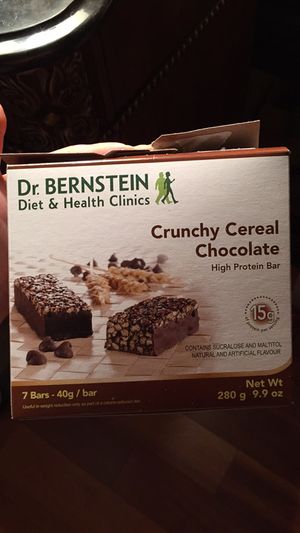 |
I chose this protein bar because it is extremely delicious. It is also a great meal replacement when I don't have time to prepare my meal. It can also be taken after workout because of Its high amount of protein. | 1.What is the difference between sugar and sugar alcohol?
Sucrose is formed from glucose and fructose linked together.Its main sources are fruits, roots and some grasses. and its sweetness index is 100 and it increases blood glucose level. sugar alcohol has both natural and commercial sources. naturally it is present in a variety of fruits and berries and commercially it can be produced through hydrogenation. the main differences between sucrose and sugar alcohol are sweetness level, promotion of tooth decay and raising blood glucose level. sugar alcohols do not promote tooth decay since they are not fermentable by bacteria.Moreover, they are less sweet than sucrose d do not increase blood glucose level. in addition, since sugar alcohols are absorbed slowly in large intestine, they will have a laxative effect if taken in excess. (lesson 2 and 3) 2. Is sucralose harmful? how it is different from sugar alcohol? as mentioned in the previous question, sugar alcohols are low caloric sweeteners that are less sweet than sucrose. On the other hand, sucralose is a non-caloric sweeter which contributes 0 calories and is 600 times sweeter than sucrose. moreover, sucralose is a chlorinated molecule in which the 3 hydroxyl groups are replaced by chlorine,whereas sugar alcohols have both natural and commercial sources as mentioned in the above question. (lesson 3) 3. How does it still remain chewy after a long storage time? this was not discussed in class. however, according to my research, the chewy and crispy profile is mainly created by the use of fats.in this product the potential ingredients responsible for this flavour are canola oil, palm kernel and modified palm oil. the packaging plays an important role to protect the product against light, oxygen and microbial contamination. therefore, the product will remain chewy until the expiry date is reached. (lesson 2 ) 4.What method is used to make the product gluten free? how is gluten harmful? we have not gone over this in class. however according to my research through wikipedia, gluten can cause gluten-disorder diseases such as Coeliac disease, wheat allergy, gluten ataxia and a few more. since these gluten related disorders have been recently increasing, it is safer to consume gluten free products. I could not find any relevant information about the actual process by which gluten is removed from products. this topic will definitely be something that i will look in to for future research. (wikipedia) 5.Why does this bar contain sodium? is due to processing or does it affect the flavour? sodium not only contributes to the overall flavour of the product, but also acts as a preservative by bindign the free water available for microbial, enzymatic, and chemical reactions. (lesson 2) |
| Anna Hee Jae Kim | 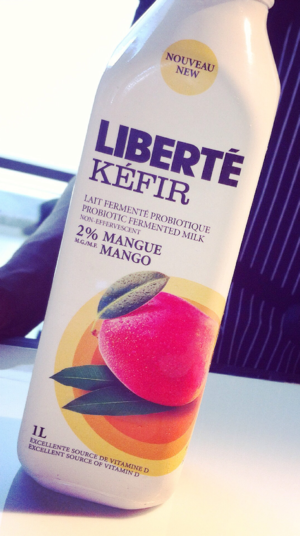 |
I chose this item because I drink this almost every day and find it better than other yogurt products as it has much higher probiotic content. | 1. How are the probiotics added to the drink and what do they do? - The method of how the probiotics are added is not discussed in the lecture, however, with research, I was able to find in what condition the probiotic cultures are in when they are put into the milk. The starting ingredient, milk, after the pasteurization process(this is done to ensure that the starter culture becomes the dominant portion of the microbial population in the milk), is combined with lactic acid producing bacteria (probiotics)in the form of kefir ‘grains’ which are a gelatinous mass of water-soluble polysaccharide known as kefiran, and lactic acid producing bacteria, yeasts, and milk components. With the added kefir grains, the lactose inside milk is converted to lactic acid through the biochemical process of fermentation. The lactic acid is the acidulant and preservative agent in responsible for the sour flavour in the kefir. For lactose, intolerant individuals, this fermented milk drink is easier to ingest for them as it does not contain lactose, but lactic acid. - Lesson 2(lactose), 9(fermentation), and 13(lactic acid bacteria). Additional information can be found in these scholarly articles: http://journal.frontiersin.org/article/10.3389/fmicb.2015.01177/full and http://www.ncbi.nlm.nih.gov/pmc/articles/PMC3833126/
2. How is the fat content of the drink modulated? - As I recall, this may have been very briefly covered during lectures, but it is not explicitly covered in the lessons. However, I found the necessary information on the FNH200 wiki page that team 12 had compiled from 2012 on yogurt. Because yogurt and kefir share the one major common ingredient, milk, and go through very similar processes for making them, it may be safe to assume they have same processes as to how the milk composition, including the fat content, is modulated. The composition of milk is adjusted for the desired fat and solids content. The manufacturers do this by clarifying and separating the cream from the milk, so the milk may have varying compositions of fats and solids such as 0% of m.f., 2% m.f.,. etc. - http://wiki.ubc.ca/Course:FNH200/2012w_Team12_Yogurt 3. If there is any, what kinds of additives are used? - This is not covered in lectures or in class. The ingredients for this product are partly skimmed milk, fruit preparation, bacterial cultures, and vitamin D3. From the following list, there are no additives. As I mentioned above, this may be because the lactic acid formed during the production of the kefir is responsible for preserving the quality of the product by lowering the pH of the product. The list of ingredients for this product can be found on the manufacturer’s website - https://liberte.ca/en/products/costco-strawberry-mango-kefir 4. What determines the shelf life of this product? (additives, packaging, etc.) - This information is not directly discussed in lectures, but, based on my knowledge learned from FNH200 lessons 5, 7 and 9 on pasteurization, packaging and fermentation, the self life of this product is maintained by controlling the container, ingredients, and all the environmental conditions as well as the packaging material that are modulated to prolong the shelf life of the product. The milk, and container, along with other ingredients are pasteurized. The fermentation process of kefir itself is a preservation method that adds to the prolonged shelf life; the encouragement of growth and metabolism of alcohol and acid-producing microorganisms to suppress the growth and metabolic activities of proteolytic and lipolytic, spoilage-causing microorganisms, and this forms the basis of microbial antagonism. The cultures in kefir produce acids and alcohols, which are the antimicrobial agents. The container is made of and sealed with non-translucent plastic to prevent any oxygen, light, and all other possible contaminants from entering the product. After the packaging process, the product needs to be maintained in a stable condition at set temperatures to prevent any spoilage. This product at 4°c - http://www.kefir.biz/ferm.htm 5. Compared to other probiotic drinks, this one comes in much higher volumes. Why is the drink packaged in 1L containers?- This is not discussed in the lectures or in the lessons, and not much information is found with further research, but with knowledge gained from FNH200, and with personal knowledge, the reason can be implied that because this product is drinkable (thinner), it is much easier to consume kefir in larger quantities than compared to the ones that need to be consumed with spoons (stirred yogurts). Also, considering the fact that milk as well as any other beverages comes with varying volumes, similar logic can be applied to this fermented yogurt drink. In large super markets and grocery stores, larger volumes of milk, yogurt are sold more while in schools and cafès, smaller volumes are sold due to the fact that the consumers are often required to consume the products in one sitting. Therefore, the volumes of beverages consumers purchase depend largely on their lifestyles and preferences.
|
| JaeKoo Kim | 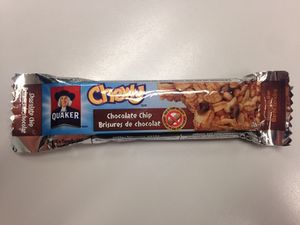 |
I chose this chocolate chip bar because I usually wake up late and have no time for a meal in the morning. So I instead have this convenient bar every morning to start a day. | 1.Why is it 26gram per serving?
Can’t be sure but maybe the company of Quaker chooses the gram per serving based on the acceptable daily intake or based on the regulation of Health Canada. (Lesson 4) 2.How and who determines the ratio of ingredients? The company of Quaker determines the ratio of ingredients, and Industry Canada regulates the weights and measures of products in Canada. (Lesson 4) 3.What makes its shelf life so long? Packaging that protects the product against oxygen and light provides longer shelf life of this chocolate chip bar – (because fat is easily affected by light, heat, and oxygen). Also, a tray (air) drying can extend the shelf life – (to protect the product from microorganism). (Lesson 8) 4.Does it even expire? Yes, it does. However, the expiry date on this products is more like a "best before date" 5.Is having this chocolate bar a healthier choice than having fruits ? Can’t really say which one of them is a healthier choice. If the nutrition fact of the chocolate chip bar is compared with the nutrition fact of apple, for example, chocolate chip bar has higher fat, carbohydrate, calcium, protein, and iron. However, apples have higher Vitamin A and C. |
| Matthew Kohan | 
Image taken from www.baldersonvillagecheese.com |
I chose cheddar cheese, as it is a processed food that has been a staple in my diet for my whole life. | 1. What is used to colour it?
2. Does colouring have any nutritional effects? 3. How is commercially produced cheese aged differently than artisan cheese? 4. How do any differences in aging affect the nutritional value of the product? 5. Where is the milk for this cheese sourced from?
|
| Natalie Kunz | 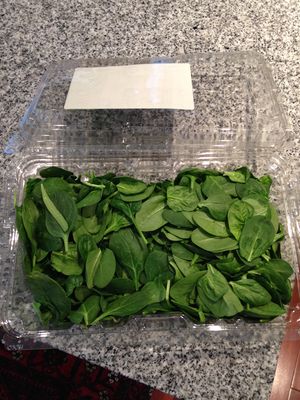 |
I chose organic, pre-washed spinach for my food. Firstly, it is easy to throw in a salad or smoothie, as it is already washed and trimmed. I also enjoy eating it and believe everyone should incorporate it into their everyday diets due to its incredible nutrient density. | 1. How soon after being picked from its plant is the spinach washed and packaged?
2. How many different spinach plants, on average, does one container enclose? 3. How do they wash and trim the leaves? 4. How do they dry the spinach, once they've been washed? 5. How are the leaves packed and sealed into the container? 1. We did not learn in FNH 200 when fresh vegetables and fruits are processed after they have been picked from their plant. However, I would guess that they are washed, dried, and packaged shortly after harvest to retain their freshness and inhibit any microbial growth. 2. FNH 200 did not include how many spinach plants are packaged in a one pound container of spinach, although there is approximately 10 cups of raw spinach leaves used for a pound of spinach ((2010). How much spinach in a pound. Produce converter. Retrieved from http://www.howmuchisin.com/produce_converters/spinach). 3. We did not learn how spinach leaves are trimmed and washed in FNH 200 but the spinach is most likely grown on a farm and then harvested. Desired leaves are chosen, ones free of any deformities, and then washed in “cold, lightly chlorinated water” ((2016). Our story. In Earthbound farm organic. Retrieved from http://www.earthboundfarm.com/our-story/0). 4. We did learn about drying methods for dehydrating foods in lesson 8, however this lesson did not touch base on exactly how fresh food items are dried after being washed. I assume that they are most likely dried with hot air blown on them or placed in some sort of heater but would need to do more research to find out the exact method of drying. Sun drying would not be ideal as it can take a very long time and is restricted to warm climates (lesson 8). Also, in lesson 5 we learned that microorganisms thrive in free water, therefore it is crucial that the leaves are dried appropriately to inhibit the growth of microorganisms. 5. Although we did not learn how the spinach is packed and sealed into the container, we did learn in lesson 5 why they are. Since spinach is a perishable food item (has a shelf life of less than 60 days) it continues to respire after harvest, which causes the cells to deteriorate (Lesson 5). Therefore, to slow down respiration, the spinach must be refrigerated, as low temperature “decreases the rate of enzymatic, chemical and microbial reactions” (Lesson 5). As well as, oxygen increases the deterioration of food, therefore sealing the spinach in the plastic container prevents any fresh oxygen from getting inside and further hindering the spinach to respire (Lesson 5). |
| Valenda Koster-Pickering | 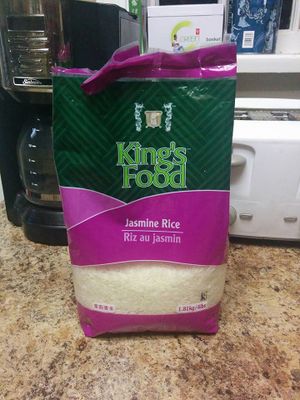 |
I chose white rice because it is a staple in my diet. It is filling and can be combined with almost any side, including vegetables, meat, sauce or even eaten on its own. It is very versatile, inexpensive and easy to prepare with a rice cooker so I eat a lot of it. | 1. How is the rice harvested?
Rice is harvested either by hand or by machine, depending on the farm. While we did not learn about many harvesting techniques specific to rice in FNH 200, a simple internet search provides all the necessary details. One thing I did not know beforehand is that the rice has to be hulled before it is dried and packaged. I also did not know that the reason rice fields are flooded is to prevent weeds from growing and deters pests from ruining the crop, which are huge contributors to crop less as we learned in Lesson 5. 2. How is the rice dried and packaged to be sold? Rice is dried by either sun drying or mechanical drying, depending on the area. We learned about methods of drying as a preservation method is Lesson 8. Sun drying is more common in Asian countries where farmers produce small batches of rice that will be consumed by them or sold locally. Since the rice I usually consume is commercially produced, I am assuming it is mechanically dried, probably by tray drying. After it is dried it would be bagged and sealed to preserve freshness. Since rice is a dehydrated food where the water is removed to deter microbial processes within it, it readily picks up moisture. For this reason, the packaging must be moisture resistant so that the rice does not spoil. All of these topics were covered in Lesson 8. 3. The rice was packaged in Richmond, BC but rice does not grow in Canada. Where was it grown, why was it packaged in a different location? While I could not find any information on the brand of rice I specifically had, I would assume that the rice was grown in and imported from either California or Asia (Japan or China). California would be the closest place where rice is grown and Japan and China would probably be fairly cheap options, and rice farms are abundant there. I would assume that they package it in Canada for two reasons, firstly so that it can be imported in bulk which might be cheaper, and also so that when it is packaged it meets all the packaging regulations set out by the Canadian Food Inspection Agency. These requirements include common name, address, nutritional information, ingredients and a durable life date. Since the requirements are specific to Canada, it might be easier to package it here so that they know it is labelled properly. We learned about packaging requirements in Lesson 4. 4. Is anything added to the rice before it is packaged, ie preservatives? Some rice might be covered with glucose or talc, or in some cases white rice is brushed with a powder that contains nutrients. These are not considered food additives as they are not listed on the food packaging as we discussed in Lesson 4. Talc has been banned in several countries including the US due to its links to cancer, however glucose is widely used in its place as it gives a nicer appearance to the grains before they are packaged. 5. What is the nutritional difference between white rice and brown rice? As learned in Lesson 11, it is inevitable that some nutrients will be lost during processing. White rice is further processed than brown rice as the bran has been removed from it, making it white rice. This additional step of processing makes the white increases the shelf life of the rice, which is the reason for creating white rice, however it also lacks many of the essential nutrients found in white rice and therefore must be supplemented in the diet. Some processed white rice is brushed with powder to add some of the lost nutrients back in. |
| Sarah Khan | 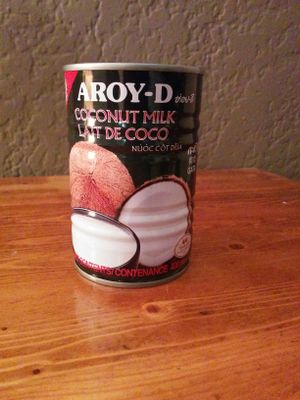 |
Coconut milk is not only delicious but also a versatile ingredient. I love using this ingredient for making healthy oatmeals, desserts and curry soups. | 1.How is the coconut milk prepared?
Coconut milk is made by mixing coconut extracts with hot water using a mechanical device. The mechanical device such as a blender uses a high speed blade to make the coconut extracts into smaller particles and disperse them evenly into the water. The coconut extracts such as grated coconut meat contains protein and a high value of fat, especially saturated fat and some levels of polyunsaturated fats and monounsaturated fat. The protein in the coconut helps with the emulsion process. The protein in the coconut milk are amphiphillic molecules and they bind with the oil and the water. Canned coconut milk may also use other emulsifiers such as monoglycerides to maintain the colloidal dispersion. The monoglyceride is a type of fat droplet (dispersed phase) that will stay suspended in the water (continuous phase). Furthermore, stablizers such as guar gum and xanthum gum also uses a thickening agent to maintain the viscosity of the coconut milk in cans. Taken from Lesson 2: Chemical and Physical Properties of Food. 2. How does it stay fresh in cans? First of all cans under go heat treatment to kill harmful microorganisms and inactivate the enzymes in the food to prevent food spoilage. The contents of the can are heated for a temperature of 250 Fahrenheit (121 Celsius). The contents of the milk will be heated through a process of convection heating. The time of the heating will depend largely on the consistency of the food and the chemical composition of the food. Moreover, the fat and added salt in the coconut milk may be also effect the heating and exposure time of the canned coconut milk. Once the coconut milk has been canned and undergone heat treatment, the can itself will control the food's exposure to temperature, moisture, oxygen and light and thus control the quality of the coconut milk. Canned coconut milk is shelf life stable, which means that the shelf life is greater than 6 months. However, once the can of coconut milk is opened, the coconut milk taste rancid after a week. Lesson 5 and 6 Wikipedia page on coconut milk: Wikipedia page on coconut milk 3. Is there any way the coconut milk can go bad or loose its freshness? See question 2. Metasulphite is also added to the coconut milk to slow down the chemical reactions and the enzymes. But this does not completely stop the chemical reactions. As a result, the canned coconut milk can still expire after two years as long as it still remains sealed. Lesson 5: Rational for Food Preservation 4. What happens when the coconut milk is exposed to high heat? When exposed to high temperatures, the coconut milk starts to curdle. The protein in the coconut milk separates from the water and the oil thus disintegrating the colloidal dispersion. The little curdles in the coconut milk are little specks of protein separating from the water and oil. Exterior website 5. Can coconut milk be described as a food colloid? Yes, coconut milk uses colloidal dispersion of coconut extracts in water to become a 'milk'. The protein in the coconut milk helps with the emulsion with the water and fat in the coconut milk. Manufacturers also use other emulsifiers and stabilizers to maintain the thickness and homogeneity of the canned coconut milk. Lesson 5: Rational for Food Preservation |
| Claudia Kobetitch | 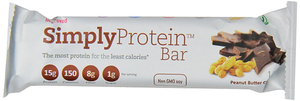 |
I chose this bar because I work for a marketing company, and I spent this past weekend promoting this bar at the Gluten- Free expo at the Vancouver convention centre. It's a soy based protein bar, that I now have a bunch of samples of that I have been snacking on. | 1. What is the difference between whey protein and soy protein?
2. Is there a plant-based estrogen that comes from soy? 3. Are soy products bad for men? 4. How does protein keep you full? 5. Since chicory root fibre is used as the sweetener in this product, is it a healthier alternative to sucrose/ fructose? |
| Apollina Kyle | 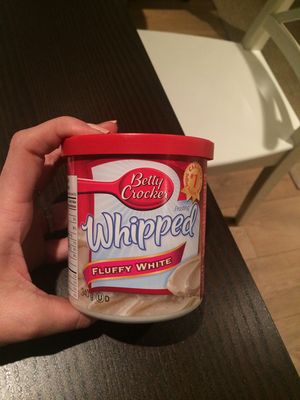 |
I chose this item because when I bake cupcakes I love the way whipped frosting tastes compared to others. | 1) Why does the ingredients not include any indications of lactose but the packaging says it may contain milk ingredients?
Because they processes this product at a factory that may process milk products. Even though the frosting product does not have milk in it, it may be cross contaminated therefor the factory must label accordingly. 2) What causes this frosting to have such a long shelf life? This frosting has a long shelf life of 5 - 6 months because it is a tetra pak carton that went through UHT processing as we learned in lesson 6. 3) Does whipped frosting have different nutritional value vs. traditional frosting? Surprisingly, whipped frosting has more fat and more trans fat than the Rich and Creamy counterpart. Whipped frosting has 9 grams of total fat and 110 calories while Rich and Creamy 5 grams of total fat and 140 calories, both in a 2 tablespoon serving size. 4) Does whipped frosting have a different shelf life compared to traditional frosting? They have the same shelf life because they are both in the same packaging from the same factory. 5) Can you substitute the high maltose corn syrup with high fructose corn syrup and have the frosting still taste the same? As discussed in lesson 2, high fructose corn syrup has a sweetness value of 100-160 depending on the percentage of fructose. Maltose only has a sweetness value of 20 therefore the frosting would not taste the same. It would be extra sweet!
|
| Hayashi Kentaroh | Photo and Caption | Why You Chose this Food? | Your Questions |
| neda keshtkar | 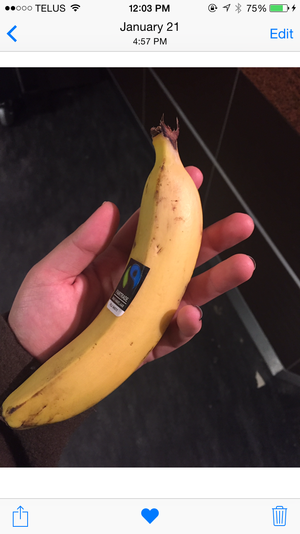 |
i am a vegetarian who eats bananas excessively | why is it when the outside of the banana turns brown the inside does not?
there was not too much in detail information about this on the internet and it was not discussed in class however this website provides helpful explanations http://wonderopolis.org/wonder/banana-bruise/ what makes the colour of the banana yellow? http://germaniumm12.imascientist.org.uk/2012/03/why-are-bananas-yellow-and-why-does-the-skin-taste-weird we have not discussed this matter in class however this website says that you can find bananas in red and purple too however the reason that the majority of the ones available to us is in yellow is because of a chemical called "Auxin" which is what is used to ripped bananas why do people associate bananas with a meal replacement? we have not talked about this in class and there is not too much information about this on the internet but, because bananas have high protein, approximately equivalent to the amount we should be consuming in a meal, they are associated with meal replacement how does the protein in bananas translate in our bodies? once again we have not discussed this in class and there isn't any good websites explaining the answer for this however i found one website that provides other nutritional facts about bananas that can help me understand how bananas work in our bodies better http://healthyeating.sfgate.com/nutrition-banana-give-body-1380.html what is the best season for banana production? http://www.bananalink.org.uk/how-bananas-are-grown we have not talked about which seasons bananas grow in, in class however this website has great information and states that bananas do not have a specific season for growing |
Family Names that Start with 'L'
| Your Wiki ID | Photo of the Food | Option A: What happened? Option B: Why Did You Select This Food? |
Questions You Have |
|---|---|---|---|
| Rachel Leung | 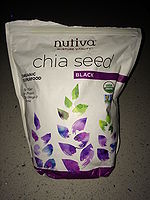 |
Chia Seeds are my favorite topping for oatmeals, smoothies and puddings. It always amazes me how they swell up into little jelly balls after just being in liquids for a little bit. They are essentially tasteless but are an excellent source of protein and fiber! |
1) What is the chemistry behind its physical swelling and jelly forming? 2) Does the rate of swelling differ between different kinds of liquids? 3) Which part of the Chia plant are these seeds harvested from? 4) How many seeds can be harvested from one plant? 5) Are the growing conditions for this plant very specific? Can they be reproduced so that one can grow them at home? 1) While the swelling and jelly forming of specifically chia seeds was not covered in class, we did talk about gel formation in Lesson 2. I conducted my own research and found that the gel produced by chia seeds is very similar to gelatin, consisting of polysaccharides made up of carbohydrates and crude fiber (Coorey et. al 2014). From Lesson 2, I learned that a common polysaccharide that is capable of gelatinization is starch. Starch granules absorb water, which converts hard items, such as the chia seed, soft and easily chewable. SOURCE: Coorey, R., Tjoe, A., Jayasena, V. (2014) Gelling Properties of Chia Seed and Flour. Journal of Food Science: 79(5): E859 – E866. DOI: 10.1111/1750-3841.12444 2) The rate of swelling, or gelatinization, was not discussed in class but I would guess that the rate would depend on the number of starch granules present in the food product. The more starch granules present, the faster water can be absorbed, and the faster gelatinization can occur. After researching more into the the rate of gelatinization, I found that my hypothesis was correct. Food scientists compare “water-starch ratios” between food products to determine the speed of gelatinization (Ndife et al. 1998). SOURCE: Ndife, M., Sumnu, G., Bayindirli, L. (1998) Differential Scanning Calorimetry Determination of Gelatinization Rates in Different Starches due to Microwave Heating. LWT – Food Science and Technology: 31(5): 484-488 3) Chia seeds are found at the flower heads of the plant. One can begin harvesting once all the flowers have fallen of the head. Flower heads should be individually picked by hand and left to dry. Once completely dried, they can be crushed with the palms of your hand and rubbed to extract the chia seeds. Next place the extracted seeds and debris into a sifter to separate the contents of the mixture. SOURCE: LongTimeMother. (2016, March 30). How I Grow and Harvest Organic Chia Seeds. [Den Garden] Retrieved from https://dengarden.com/gardening/How-I-grow-and-harvest-organic-Chia 4) Depending on the size of the growing area, each chia plant can produce anywhere from 1 teaspoon to 1 cup of seeds. SOURCE: ChrysN. Sprouting Chia and Other Small Seeds. Retrieved from http://www.instructables.com/id/Sprouting-Chia-and-Other-Small-Seeds/ 5) Chia seeds grow mostly in tropical and subtropical latitudes due to its long growing season. Chia seeds can definitely be grown at home, as long as there are a few altercations to the home environment. Chia seeds grow best at high temperatures, roughly 70 to 85 degrees Fahrenheit, so a space heater and heating pad should be used. Tap water in cities may also contain chlorine, which may slow the growth of the seeds. Filtered water would be ideal if growing the plant at home. SOURCE: Duvauchelle, J. Tips on Growing Chia Seeds. Retrieved from http://homeguides.sfgate.com/tips-growing-chia-seeds-48087.html
|
| Yee Jin Low | 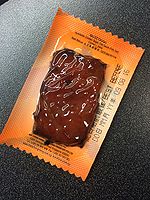 |
I chose this food because it is a pre packaged food and therefore is always available whenever a light snack is needed. Furthermore, I always ate this since I was a young child so I eat it now whenever I feel home sick as I am an international student. | 1) How is the meat cooked in order to achieve this taste?
From Lesson 6, commercial sterilisation could have been done initially to cook and reduce both spoilage and disease causing microorganism in the meat itself. During its cooking, it probably underwent the Maillard Browning Reaction as this would contribute to the sweet taste of the meat (Lesson 2). The fat from both the meat and oil contributed to the taste as well as it contributes with its tenderising power and moist feeling when chewed (Lesson 2). 2) Are there any chemicals used in the 'preserving' part of processing or is it all due to vacuum packing? To my knowledge, nitrites could have been added to the meat to extend storage life as well as to make it look more appealing (Lesson 4), but there could be other chemicals added for preservation purposes. A way to know is to find the website of the company online and find the ingredient list. Furthermore, vacuum packaging inhibits the growth of aerobic spoilage-causing bacteria as said in Lesson 7. Therefore, the use of chemicals and vacuum packaging both contribute to the 'preserving' part of the food. 3) What are the steps used to process the meat to its final product? I still do not know the answer but I will make an educated guess. Originally, the meat would have been obtained from a slaughter house and cut into the desired size. From there, it would be cooked to obtain the desired flavour and kill off any non desired bacteria (Lesson 6). After that, it would be vacuum packed and transported to sellers. 4) Can vacuum packing work for all types of food? We certainly can vacuum pack foods but it will not be beneficial, so therefore it won't be good to vacuum pack all foods. This is because for some food with large air spaces in between food compartments will get crushed in vacuum packing due to the food collapsing on itself. This would decrease the structure of the food and hence the desirability of the food. Also, this method is only to prevent aerobic spoilage-causing bacteria whereas there exists anaerobic spoilage-causing bacteria (Lesson 5) which some foods contain and need further processing in order to be safely consumed. 5) Will we be learning about vacuum packing, if not, what are the steps to vacuum packing? We did learn a bit about vacuum packing as it was similar to Modified Atmosphere Packaging (MAP) except there would be no back flushing (Lesson 7). The steps would be packing the food in a flexible packaging and suck out all the air with a vacuum. Then seal it completely to refrain any air from entering. |
| Jessica Liang | 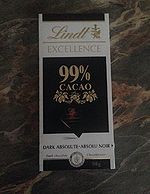 |
I chose dark chocolate because it's one of my favourite foods to snack on. Dark chocolate is not too sweet and you can eat it as a combination with pretty much anything. Compared to white and regular chocolate, it's a healthier option and provides many health benefits. | 1) What is the difference between a 65% and 99% dark chocolate bar? Answer = We didn't really go over this but according to research, the percentages on dark chocolate bars indicate the ingredients derived from cocoa beans by weight. Examples include chocolate liqueur and chocolate solids. When you compare 2 chocolate bars with the same percentage, they may taste different despite having the same percentage. This is because a 70% dark chocolate bar could have different weights of ingredients like 50% cocoa butter, 20% solids, or 40% butter and 30% solids. However, "unsweetened" chocolate is always around 85-95% cocoa. "Bittersweet" chocolate contains 35-84% cocoa and "semisweet" 15%-34%
2) How long does it take to make a chocolate bar? Answer = Making a chocolate bar is of a careful process. According to Lessons 5,6,7, you need to clean the cocoa beans before roasting them. Then, you separate parts of the cocoa beans (i.e. separate the shells), then blend formula / use specific recipes to make a particular type of chocolate (i.e. milk, flavoured chocolate), then add emulsifying agents. Lecithin, a type of phosphate also known as phosphatidyl choline, is commonly added into chocolate. The last process is for the chocolate to pass through a heating and cooling process (preservation) in order to package it at the end. 3) Are the nutrients in dark chocolate susceptible to destruction by being stored in a room at high temperature? Answer = Since chocolate contains fat, it is very susceptible to light, heat, or oxidation. Because of that, chocolate is packaged in a way that prevents light from going through. For instance, chocolate bar wrappers consist of different layers (i.e. adding aluminum) instead of clear containers. This is to prevent light, heat, and oxidation processes to occur. Keeping chocolate in a cool, dry, dark area may be a good method in preserving it. 4) What makes dark chocolate more expensive than regular white or milk chocolate? Is it the nutrients? Answer = Dark chocolate consists of more cocoa beans than milk or regular chocolate. It also adds many benefits to an individual, such as decreasing risks of heart disease. In fact, dark chocolate is actually good for you. 5) How is chocolate made from cocoa beans? Answer = According to Lessons 5,6,7, you need to clean the cocoa beans before roasting them. Then, you separate parts of the cocoa beans (i.e. separate the shells), then blend formula / use specific recipes to make a particular type of chocolate (i.e. milk, flavoured chocolate), then add emulsifying agents. Lecithin, a type of phosphate also known as phosphatidyl choline, is commonly added into chocolate. The last process is for the chocolate to pass through a heating and cooling process (preservation) in order to package it at the end. |
| Choi Yee Lau | 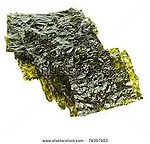 |
I chose this food because it is my favourite study snack because it is low in calories and fat, yet it satisfies my cravings for unhealthy salty snacks, like Doritos. Also, dried seaweed contains antioxidants and vitamin B-6, which is beneficial for the brain health and function (more reason to love this snack for studying). In addition, this food can be used on different types of meals, like adding it on rice or having it in your sushi! | 1) Dried seaweed have many health benefits but after all the steps of processing it goes through for dehydration, packaging, preservation, and importation, will the health benefits still remain in the food?
We did not learn specifically about this in FNH 200, especially the changes through processing would differ depending on the food. According to the website of Riding Tide Sea Vegetable, the salt that is naturally on the seaweed helps preserve. However, over time seaweed will lose its flavour and nutritive qualities. The website suggests that its best to be used within the first two years. 2) Are there any health deficits if one consumes a large amount of seaweed? This specific question was not covered in FNH 200. According to Livestrong, seaweed contains a high level of iodine. It is possible for one to consume too much iodine, which can cause one to develop an enlarged thyroid that would result with symptoms like gastrointestinal issues, nausea, skin problems, diarrhea, and vomiting. 3) How is the snack made from the original seaweed itself? According to lesson 8, seaweed is best when naturally sun dried. However, it can also be dried in an oven. 4) What allows the dried seaweed to be able to last for a long time? According to the website Riding Tide Sea Vegetable, seaweed never rots because the natural salt helps preserve it, but longer it sits, the more of the flavour and nutritive qualities will be lost. 5) Where is the best place the seaweed should be imported from? I could not find an exact location, but from the sources I've read, the location of where the seaweed is harvested does not have a huge influence, but it is how its dried and processed. |
| Alejandro Leiva | [[2]] | I chose this food because it is a very convenient and fast snack on the go that provides good energy from carbohydrates and fats. It is also high on protein. | 1. Why can´t they make protein bars from whey concentrate protein and almost all are from soy protein?
Answer Q#1: Both whey and soy protein concentrate are good sources of protein, however, soy protein may have improved flavour and color. Perhaps Kellogs also wishes to address the vegan market as they cannot eat whey protein because it is derived from dairy. Kinsella, J. Functional Properties of Soy Proteins. Cornell University. 2. What is palm or coconut oil shortening? Answer Q#2: It is an oil that has some of its unsaturated fats removed, making it a semi-solid butter texture. Lesson 02 3. What is the purpose of adding calcium carbonate in some products? Answer Q#3: In this product it may be used as a calcium source (FAO, 2016) 4. Is it mandatory to claim that a product has low or zero trans fat? (I see these bars have hydrogenated (trans fat) oil and they do not claim that in the packaging) Answer Q#4: The conditions for trans fatty acid claims are linked with the content of saturated fatty acids. Lesson 04 5. What is inulin? Answer Q#5: It is a polysaccharide. Type of dietary fiber known as fructans. |
| Jordan Leong | [[3]] | I chose this food because i use it everyday, sometimes twice a day. I use it to gain muscle and it is essentially a supplement not a whole food and it contains a high amount of protein relative to other macro nutrients and 130 calories in total. It is a powder form and is mixed with water to be consumed in a fluid state. | 1) How is so much protein condensed into such a fine powder?
2) What type of protein is it? 3)Does more water make the flavors taste more dilute? 4)Do different flavors give more protein 5)Does it expire or deteriorate quickly compared to whole foods? 1) milk undergoes the same processing as cheese and the whey protein is drained from the milk. It is then spray dried , which we learned of in the preservation methods of dehydration lesson as a preserving technique however, for whey protein this is a storage and a preserving technique. 2)It is a milk protein, there are 2 casein and whey, i believe Judy talked about this briefly in class but i dont remember it in the lessons, casein is more slow digesting and whey is more fast digesting. 3)This question is pretty obvious i would say yes definitely, more water makes the taste much more dilute. 4) We learned about this is the additives section that additives have no macro nutrients such as carbs, proteins or fats, therefore different flavors do not give more or less protein. An additive that we have learned in class that this protein has is xanthan gum. 5)It expires relatively the same expire date as instant noodles, being from around 2 years. Some foods expire quicker than this such as milk, which is strangely where whey protein originates from. |
| Nian Liu | 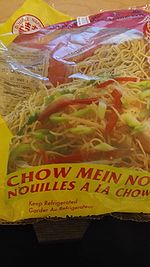
|
I usually chose this kind of chow mein noodles to substitute the instant noodles. It looks healthier and can be cooked quickly. Also, it tastes good. I use it to make soy sauce flavor noodles in the dorm. | 1)Why could this kind of noodles being stored for so long?
2) How could taste being totally different after put into hot water? 3) After absorbing enough hot water, how could it still absorb soy sauce? 4) Why there is iron in this kind of noodles? 5) What is the function of iron in the noodles? |
| Amira Lalani | 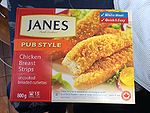 |
These chicken strips are a fan favourite in my household. It's just so quick and easy to prepare for the picky eaters. Interestingly enough, we've tried different brands, but Janes is the only one we prefer! | 1) What part of the chicken is used?
2) How are the strips prepared before freezing? 3) What processes are involved with freezing? 4) Do the seasonings aid in preservation or are they simply for the flavor profile? 5) How does this product taste so good after being cooked from frozen and how does the manufacturer know the proper cooking timings? 1. I can't really answer question #1, simply based on the fact that we haven't covered the material. However, the FAO website, http://www.fao.org/docrep/010/ai407e/AI407E15.htm has some information that touches on how different cuts of meats used in various ways. 2. Again, I'm not exactly sure how the strips are prepared, but my guess is that there is a machine that cuts the meat into uniformed strips. As well, I don't think dehydration is used on the chicken, but rather concentration is used. This is because not all of the water is removed from the chicken, otherwise it wouldn't have the juicy effect it does when cooked. Moreover, the strips are frozen, which fits with the concentration method, as seen in Lesson 8. 3. Based on Lesson 7, my guess would be that the company uses the plate freezing technique, which works well since the strips are all the same size, shape, and amount of coating used. 4. We only touched on a bit of the role of seasonings, however, Lesson 5 talked about the role of salt and sugar as means of preservation, so these ingredients delay the growth of bacteria (food spoilage) and prevent mold from occurring. As well, these preservatives also decrease the water activity within the chicken, so freezing can take place properly and in full effect. 5. In regards to proper cooking times, I can't answer that but my best guess is that the company has done many tests to determine the proper cooking temperature and length of time required. As well, there is a label on the box that says "cooking times may vary", based on the various types of ovens and their strengths. However, Lesson 7 explained 5 important topics: rate of freezing, final storage temperature, stability of storage temperature, the rate of thawing and proper packaging techniques for frozen foods. All 5 of these topics are incredibly important to the quality of frozen foods, from the initial freezing at the manufacturing site to transportation and storage at grocery stores and at our homes.
|
| Carissa Law | 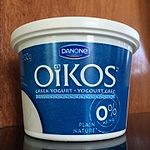
|
I eat greek yogurt almost everyday; for breakfast or even for a snack. It is filling, nutritious and delicious. I always choose the 0% version because i am the type of person who is conscious of the fat content of food constantly, | 1) How did they take away the fat from the yogurt?
2) Why is it so much thicker than normal yogurt? 3) Why can it be stored much longer compared to normal yogurt? 4) Why is there so much more protein in it compared to normal yogurt? 5) What are the step involved in making this product? |
| Olivia Lam | 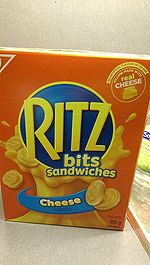 |
These biscuits are my absolute guilty pleasure. It's basically a heart attack in a box so I try to eat these only if I'm absolutely craving them, which is most of the time. I'm picky with my choices though - I only like the cheese version. | 1) What processes were required to make the "cheese" in the biscuit?
2) Why use Modified Milk Ingredients when you can use real milk instead? 3) The packaging states that there are no artificial flavouring or colours, yet the last ingredient in the ingredients section is "Natural Flavour". What is Natural Flavour and what is considered "natural"? 4) Where was this product made? There are no indications of where the product was manufactured, with only an "Imported by" section. 5) Why is amylase used in the product? Does it mean that the product is "pre-digested"? |
| Jaidan Lee | 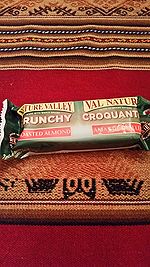 |
These bars are my food of choice during school and study sessions. As well these bars are quick and easy to bring around. Besides the mess they create after eating, they are very tasty and you can always find them on sale at safeway or other such stores. | 1) How many different ingredients are used in the making of these bars?
A: There approximaly 14 ingredients listed but one of the ingredients is listed as "natural flavor" and that can be listed as food additives as discussed in lesson 4. But this ingredient is listed as last so therefore there is the least of it in this food. As well the numerous additives added is so miniscule that it can be written as a general term of “natural flavor”. 2) Are the ingredients local? If not how far does the furthest ingredient originate from. A: These ingredients are not local as this snack food was processed in Mississauga and shipped into Canada. 3) Is the production of these bars fully automated or is there some human interaction in the creation of this food A: These bars are most likely completely automated due to the huge volume needed. The only interaction would be humans putting ingredients into the mixers and taking the finished products and moving them on to shipping pallets. 4) What perservation techniques are used to extend the shelf life of this food A: These bar are very dry most likely cooked via a tray (air) drying (lesson 8) so there very little water which greatly extends the shelf life. As well the packaging is similar to a retortable pouch (lesson 6) as there is a silver lining. This packaging increase the shelf live by keeping the air/moisture out which prevents the growth of microorganism. 5) How long does it take to create one bar from start to finish. A: Unsure how long it takes to create a bar, but due to the high automation of these bar, the time of completion should not take more than a couple of hours. |
| Rebecca Lo | 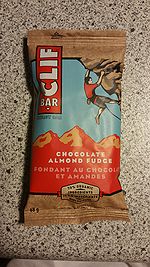 |
It is a quick and easy snack while I'm on the go, especially because I don't have much time. | 1) The bar itself is quite moist, and seems to expire relatively fast compared to other energy bars, what ingredients within the bar contributes to the moisture content, and how do manufacturers account for this?
2) The bar claims to be 70% organic. Do organic ingredients contribute to a faster expiration date? Additionally, what are the added benefits of the organic ingredients? 3) Cliff bars are energy bars, what is in the bar which helps provide energy upon consumption, and how does it do this? 4) It states that it is a nutritional supplement, how many Cliff bars does one need to consume in order to achieve the daily amount of necessary nutrition? 5) The Cliff bar contains various vitamins and minerals, one of which is copper. What is the additional benefit of adding copper into the bar, and what materials were used in order to add this into the bar? |
| Shi Ye Liu | 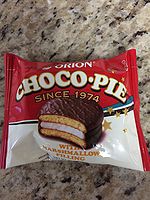 |
These chocolate pies are my breakfast when I rush to a class, and doesn't have time to get proper meal. They taste pretty good and easy to carry around. I bought them from the Chinese supermarket T&T. | 1) Which ingredients are responsible for the flavour of this chocolate pie?
A:Wheat Flour, Sugar, Tapioca Glucose Syrup, Vegetable Shortening (Palm Oils, Hydrogenated Coconut Oil, Hydrogenated Palm Oil), Hydrogenated Vegetable Fat (Palm Oil, Shea Oil), Tapioca Isomalto Oligo Syrup, Cocoa Powder, Contains Less than 2% of: Whole Milk Powder, Eggs, Dextrose Monohydrate, Gelatin, Salt, Sodium Bicarbonate, Ammonium Bicarbonate, Monocalcium Phosphate, Hydroxypropyl Distarch Phosphate, Vanillin Powder (Artificial Flavor), Soy Lecithin, Hydrolysed Milk Protein, Xanthan Gum, Polyglycerol Polyricinoleate. Most of the ingredients can be defined into three categories: Carbohydrates, fats, glucose and protein. These messages relate to Lesson 2 &3.
A:The shelf life for Orion choice pie is 1 year. The food company uses reportable pouch, and paper box package. Since it is chocolate pie which would need to keep its shape, reportable pouch is the best way to package it. This message relates to Lesson 6.
A:Most ingredients are natural products. This message relates to Lesson 4.
A:Since most of the ingredients are carbohydrates, fats, glucose and proteins, it provides mainly energy to consumers. However, in the nutrition table, it shows that there is 4% Iron per serving. This message relates to Lesson 2.
A:Since this chocolate pie is not very nutritious, it is not very good choice as main food sources. Also, if the shelf life ends, it should not be consumed. Moreover, since it contains a lot of energy, it might cause obesity if someone over consume this kind of food. Therefore, it is not suitable for long time regularly daily consume. This message relates to Lesson 2 &6. |
| Travis Lam | 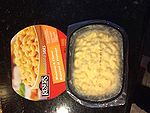 |
I chose this particular food because it's quick and easy to make while still being delicious, at least in my opinion | 1) How is the cheese prevented from going bad?
2) How does the macaroni maintain the texture of typical macaroni while being soaked by cheese for long periods of time? 3) Why must we add more water or milk during the preparation of this meal? 4) What has been done to this food that allows it to be prepared so quickly? 5) Will a high amount of consumption of this particular food cause any health problems?
|
Family Names that Start with 'M'
| Your Wiki ID | Photo of the Food | Option A: What happened? Option B: Why Did You Select This Food? |
Questions You Have |
|---|---|---|---|
| Amanda Mar | 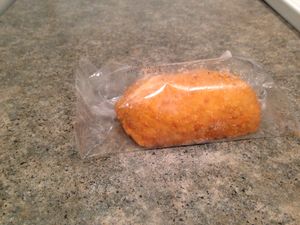 |
I chose this because I have always eaten them since they are quick and easy to make. However I would like to know more details about it to see if they are healthy or not. | 1) How is the chicken being processed?
In this class we did not discuss how chicken products are processed. I found a website that briefly describes the process of how chicken nuggets as I could not find any sources on chicken cordon bleu. They are also very similar. The chicken meat is grounded and breaded, then cooked often by baking or deep fried. http://www.nationalchickencouncil.org/whats-in-those-chicken-nuggets/ 2) How does the chicken get made into this shape? Again we did not discuss this in class. It may be due to the freezing technique used. We discussed the various types of freezing techniques in Lesson 7. The one most likely used for chicken cordon bleu is plate freezing which would account for why they are all similar shapes. By having consistency the freezing is more evenly distributed and they can fit on the plates easily. 3) Why is there no expiry date? In Lesson 4 we learned about labelling requirements. Food products that have a shelf life less than 90 days require an expiration date. Since the chicken cordon bleu is frozen it will last longer than 90 days and therefore is not required to have one. 4) Does it make a difference if the food is fully cooked vs raw before being frozen? We did not discuss this in class however I was able to find a US site that discusses freezing food safety. http://www.fsis.usda.gov/wps/portal/fsis/topics/food-safety-education/get-answers/food-safety-fact-sheets/safe-food-handling/freezing-and-food-safety/CT_Index Food that is cooked and then frozen may lose some quality because of the moisture lost. It also takes less time to reheat frozen food that was cooked previously versus raw. Other than these two points I was not able to find any other major differences between food that was cooked versus raw before being frozen. 5) Why are they individually wrapped? We briefly discussed the packaging of frozen food in Lesson 7. It must prevent the transfer of water vapour from the food to the freezing unit environment. The packaging also must not break in cold temperatures. It also has to not allow pinholes to be made during the handling of it because if the package breaks the food is susceptible to freezer burn. Light and oxygen may have to be deflected as well but this depends on the food. Each chicken may be individually wrapped to ensure optimal conditions are maintained for each product. It also comes in a cardboard box, adding further protection during the processing and handling. |
| Melanie Mayede | 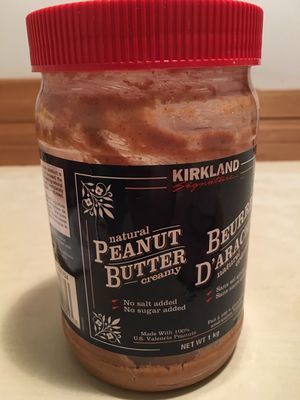 |
I chose peanut butter because it is a very versatile food that can be used in a variety of different ways. I also like it because it is a plant-based source of protein. | 1. What is the difference between “natural” and “unnatural” peanut butter?
Natural peanut butter contains strictly peanuts with no additional ingredients, additives, preservatives, etc. Unnatural or conventional peanut butter may contain additional ingredients such as hydrogenated oils, sugars, salt, stabilizers, and preservatives. It would be ideal to believe that the shelf life of natural peanut butter would be limited as compared to conventional peanut butter due to the lack of preservatives. Preservatives and additional ingredients, such as sugars and salts, are used in order to prologue shelf life by binding free water, making it unavailable to microorganisms, bacteria, yeasts, etc. (Lesson 5). Natural peanut butter also tends to separate and present a layer of oil on its surface, which will be touched upon in question #4. 2. How does processing differ when it comes to “smooth” and “crunchy” varieties of peanut butter? We never covered this content in our lessons, but according to some websites, the processing of these two varieties of peanut butter are identical until the final addition of peanut pieces (about one-eighth of a peanut kernel in size) are mixed into the product to create crunchy peanut butter. (http://www.madehow.com/Volume-1/Peanut-Butter.html). From a nutritional standpoint, chunky peanut butter is said to have slightly more unsaturated fat and less saturated fats in comparison to the smooth variety. Both smooth and crunchy varieties contain similar benefits of containing fiber and some essential vitamins and minerals (http://www.livestrong.com/article/521398-health-factors-of-crunchy-peanut-butter/). 3. How is powdered peanut butter produced? Powdered peanut butter is produced through the dehydration (Lesson 8) of roasted peanuts. Since peanuts naturally contain a high fat and oil content, dehydration would lead to the removal of these fats and oils along with much of the free water from the peanuts. Powdered peanut butter is a relatively recent discovery in the food industry, but according to many short explanations about the processing of powdered peanut butter (http://simmerandboil.cookinglight.com/2015/07/31/what-is-peanut-butter-powder/), the roasted peanuts are pressed in order to remove the excess moister and fats followed by being ground into a flour-like consistency. Moisture removal from peanuts leads to physical changes (such as cell and tissue shrinkage) as well as nutritional changes (removal of fats and oils). From a personal experience, I find that adding water to powdered peanut butter (Lesson 8) shows that the overall dehydration process impacts its water holding capacity as the consistency is not the same as regular peanut butter would be as well as its taste. 4. Why does natural peanut butter separate? Natural peanut butter (made with just peanuts) can be considered as a water in oil emulsion (Lesson 2) where the fat acts as the continuous phase with suspensions of water droplets throughout. There is a tendency for the two phases of a water in oil emulsion to separate if left standing. Since natural peanut butter lacks any other ingredients, this would explain the oil layer that sits on top on the peanut butter. Conventional peanut butter usually contains additional ingredients, where one may act as a stabilizing agent in order to homogenize the mixture. Stabilizers act to increase the viscosity of the continuous phase to allow water droplets to remain dispersed in the emulsion and prevent creaming (Lesson 2). 5. What types of preservatives are commonly used in peanut butter? Common preservatives in peanut butter may include sodium benzoate and butylated hydroxyanisole (BHA), both of which prevent mould growth and food spoilage and help retain freshness (Lesson 5 and http://wiki.ubc.ca/Course:FNH200/2012w_Team13_PeanutButter#cite_note-14). We also learned about the functions and goals of the preservation process overall in Lesson 5. Preservation would be important in peanut butter and all foods to reduce biological, physical, chemical, and nutritional deterioration as well as for safety reasons relating to the prevention of microorganism growth as well as removing/killing them (Lesson 5). Preservation also helps to increase the shelf life of food products. To do this, there are many methods in addition to the addition of preservatives. Some examples include: thermal processing (such as blanching and commercial sterilization), lowering temperature (freezing and refrigeration), fermentation, and the use of radiation energy (such as food irradiation).
|
| XiaoQian Ma | 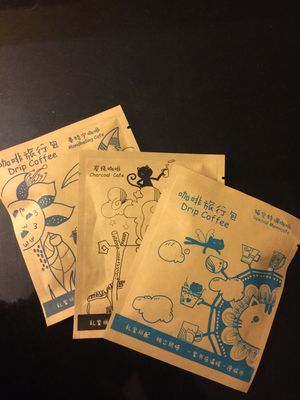 |
The reason why I chose this food which is because I really love coffee! I love the smell and the taste, and it also make me with a waking state. I chose this travel package because it is convenient to take outside, and it is not like other instant coffee. This one tastes similar as the one that offered in coffee shops and there are also many flavors that I can choose from. | 1. What are the materials in this coffee packs?
2. What makes it tastes different than the instant coffees since this one can also make coffee quickly? 3. Why the black powder in the package would not melt? 4. What makes these drip coffee so many flavors? 5. Can I eat the materials in the packages directly? like snacks? |
| Saman Mohsen Sarrafi |  |
The snack that I chose, Sohan, is considered one of the more-famous Iranian desserts that I am in love with. The perfect mix of saffron, almond, and pistachios within this cookie-like treat is what I consider to be unique enough to make this my favorite snack. | 1) How long does it take for the Sohan to be thoroughly baked? To this point, I still do not know the exact temperature that Sohan is baked at since the regulations in Iran do not require much information regarding the products be given to the consumers, not even the amount of Calories in most cases. However, I have learned in this class that heating up the food not only cooks the ingredient, but also rids the products of contamination and any possible food borne diseases (Lesson 6). The best way to gather more information will be to personally visit the factories where these snacks are produced. 2) What gives Sohan its sweetness? 3) Can Gluten-free Sohan be made? 4) Since wheat sprout oil is extremely nutritious and is also a major ingredient in Sohan, what happens to the effectiveness of these nutrients after being processed in high temperatures? 5) How would whole wheat Sohan be different from the regular Sohan that is currently available? Will there be any differences in the taste or the texture? |
| Zhen Mo | 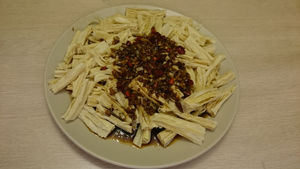 |
I chose this food because it is one of my personal favourites, it absorbs flavors just as well as soft tofu (compared to firm ones), but is chewy and much easier to pick up with chopsticks. | 1. Why is it chewy as opposed to the soft texture of typical tofu?
2. Why is the texture wrinkled? 3. How are they made flat from a typically cubed tofu? 4. Why does it appear yellower when raw and whiter when cooked? 5. If tofu is a gel, then what type of colloid (if it is still one) is this? |
| Amy Morssinkhof | 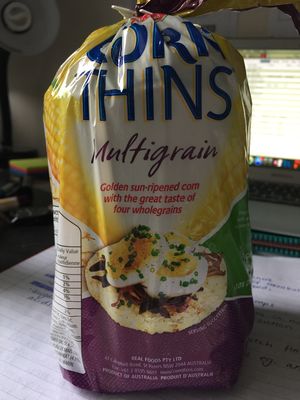 |
The food that I have chosen is Corn Thins. They are a perfect snack for any time of day. They can be eaten either by themselves or can be topped with peanut butter and vegemite. | 1) How is corn used the make corn thins?
2) How processed are they? 3) Is there a healthier option to corn thins? 4) Do corn thins expire? 5) Are they dried once they have been originally made? |
| Morgan Mudry | 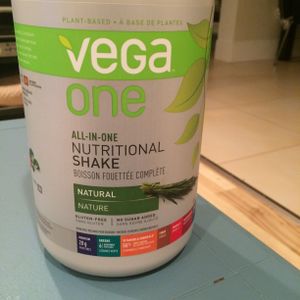 |
I chose Vega One because it is a perfect nutritional vegan shake that my partner and I use in the morning if we are too busy to cook a full meal. It still provides us with what we need nutritionally to start the day off right. Further more Vega is a local company which is gluten free and non GMO. | 1. How is the shelf life for Vega One so long?
Vega One is capable of having such a long shelf life through food preservation techniques such as dehydration (Lesson #2, 5, 8). Dehydration helps extend shelf life through removing free water that is present in the food. The removal of free water means that the water is unavailable for microbial growth, and chemical and biochemical reactions (Lesson #2, 5, 8). Furthermore, as mentioned in lesson 8 microbial growth, and chemical and enzymatic reactions happen only if there is sufficient free water available. Microorganisms cannot continue to grow with Aw below 0.6. Dehydrated foods have Aw of between 0.2 and 0.6, limiting the ability for microbial activity. (Lesson #8). It is also advised to keep Vega One in a cool and dry place away from sunlight, and to close the product lid tightly. This would be to help in preservation by: limiting deterioration from heat, sunlight and rehydration (lesson #8) 2. Where does Vega One source all their ingredients from? This was not addressed in lecture, however upon going to the website, (https://myvega.com/products/vega-one-nutritional-shake/) “More than 75% of the ingredients in Vega One are grown and processed in North America. [They] choose to source some ingredients from their native climate including: maca (Peru), SaviSeeds (Peru), and chlorella (Japan).” 3. Is this sustainable? This was not discussed in lecture, however eating a vegan/vegetarian diet free of animal and animal by products helps reduce carbon footprints. Furthermore, Vega as a company is dedicated to sustainability – they have a journey to zero goal where they strive to be a company that leaves a net-zero carbon footprint. You can learn more about their packaging efforts on their website (https://myvega.com/why-vega/sustainability/) 4. How is the food processed in order to get whole food ingredients into powdered and stable form? I would infer that Vega One is made through the process of Spray drying. The product is made of a fine powder like formula and does not clump easily unless introduced to moisture; pieces also seem very uniform in size. When water is added and the product is mixed it makes a liquid beverage. I would assume the ingredients were mixed together in liquid form and then spray drying was used to create the powdered drink. (Lesson #8) 5. Is this type of processed food as affective as consuming the raw whole foods themselves, or is the trade off for having a convenient all in one shake nutrition? As mentioned in lecture, some nutritional value is inevitably lost through processing, however to varying degrees (Lesson 11). There are so many different ingredients in Vega that it would be hard to go through every item and infer the nutritional value lost in the processing, as there are many factors involved such as whether or not the nutrients are water-soluble molecules etc.,and even what the nutrients are, along with the type of processing used and amount of time exposure to processing (Lesson #11). I would infer that since Vega One is marketed to be high in protein, and that protein becomes more available through processing that a lot of the value of Vega One is still present, however this inference would require more research using tools such as the UBC library summon and the ingredients list of Vega One. |
| Jennifer Moy | 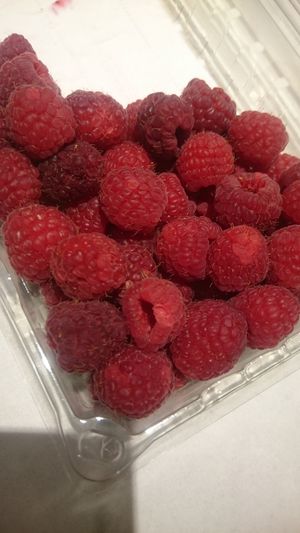 |
I chose these because I like to eat them with oatmeal in the morning, they're delicious! | 1. When are these berries in season where they were picked? (the the USA)
In california, where these berries were picked, they are in season around April-October. 2 What temperature are they kept at to preserve them till shipping? 30-33 degrees fahrenheit. 3. Are they sprayed with some sort of chemicals to keep them from rotting? if so, how does it affect the human body? Most farmers do not spray their raspberries post-harvest. Instead, the raspberries are stored at optimal conditions and handled with care to prevent rotting. 4. What do the manufacturers do with the berries that dont pass inspection because of appearance? Many raspberries are thrown away when they dont meet standards. However, the berries that do not show signs of mould, but are only smaller in size or not a 'perfect' looking berry still get packed with the rest of the berries. 5. What are the optimum conditions for the berries in order to maximize shelf life? 30-33 degrees fahrenheit, 90-95% humidity, 15-20% carbon dioxide, and 5-10% oxygen. |
Family Names that Start with 'N'
| Your Wiki ID | Photo of the Food | Option A: What happened? Option B: Why Did You Select This Food? |
Questions You Have |
|---|---|---|---|
| Si Zhe (Celeste) Ng | 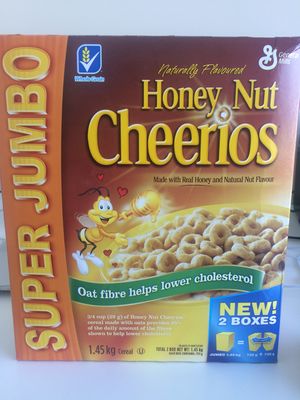 |
I chose this food because Cheerios with milk is my favourite breakfast, so I always have a box of Cheerios at home. | 1. What makes the Cheerios donut-shaped? Why is it shaped this way?
The dough is forced through holes in a die, emerged in a tubular form. A revolving knife slices the tubes into small, round sections, which then go into a puffing gun. The Cheerios pellets puff up in their doughnut shape. There is probably no specific reason as to why Cheerios are donut-shaped. A reason could be to make it cute and appealing to consumers. (Lesson 8) Sources: http://articles.orlandosentinel.com/1985-08-25/news/0320310063_1_toothpicks-toothpaste-modern-technology 2. How does the Cheerios contain natural nut flavour when there is no nut visible among the Cheerios? How is it natural? The Cheerios were made with natural nut flavor but not actual nuts. (Lesson 4) Natural flavours are made from natural sources, for example, natural nut flavours would be made from extracting chemicals giving the nutty flavor that is originally in the nuts. Sources: https://en.wikipedia.org/wiki/Honey_Nut_Cheerios, http://www.cnn.com/2015/01/14/health/feat-natural-flavors-explained 3.How are the Cheerios made? Are they baked? Answer is in question 1. Cheerios are made by extrusion drying so they puff up nicely. (Lesson 8) 4.How are the Cheerios kept crunchy in the paper box? The sealed plastic packaging prevents water vapour from getting into the cereal, keeping them crunchy. (Lesson 8) I am not sure if the air packaged inside the plastic is modified so there is less water vapour. More research could be done on this website: http://www.slideshare.net/zgoutham/cereals-and-its-products-packaging, which talks a lot about cereal and its product packaging. 5. Why is there a plastic bag containing the Cheerios inside the paper box? Why is it not sold in just a plastic bag like chips are? The paper box is used probably to protect the Cheerios from being crushed. Also, more information can be printed onto the paper box as printing on plastic can be difficult. The paper box can also protect the cereal from light. (Lesson 8) |
| Carmen Naujokat | 
|
I chose cottage cheese, because it is something I eat almost everyday for breakfast or on the side of any meal. I enjoy eating it with fruit in it, and it is a great source of protein and calcium. It's also very easy to throw together with something if I'm in a rush. | 1. How do they make cottage cheese? I found some information on the cottage cheese wikipedia page. It shows that during the cheesemaking process it is drained but not pressed. The curds remain loose but are washed as well to remove the acidic flavour and to give it the sweeter flavour it has normally.
2. What type of bacterias are involved in making it? From what I have read in lesson 9, lactic acid would be involved in the making of cottage cheese. It would probably be used as a microbial culture in order to maintain desirable traits and help with the fermentation of the cottage cheese. Under favourable conditions it begins to grow rapidly. 3. What are the benefits of eating reduced fat cottage cheese compared to the normal kind? From first group assignment we did, I can say that low-fat or reduced fat products are better for reducing the amount of fat in a diet. However, it is only good for a short amount of time due to the fact that the body does need a certain amount of fat per day. If a person were just eating this one reduced fat product in their diet, as long as they were making up for it in other ways it would be fine. 4. How many different types of cottage cheese are there (curd size, milk used, fat content)? I am unsure of this answer from the lessons, however I am sure you could find the answers through academic research and literature. However, in Lesson 9 it describes a section of cheese making called curd cutting. I’m assuming that they can choose what size of curd they want to make during this process of cutting the cheese into curds. It can be made in large curd or small curd preparations. It can also be made with different milks of different fat contents. 5. Is there any fermentation involved in the process of making cottage cheese? Yes there is fermentation involved in the making of cottage cheese. Also found in lesson 9 the making of cheese curds comes through the process of cheese making. It goes through pasteurization then fermentation, and finally curd coagulation (cutting and cooking).
|
| Jiatong Nie | 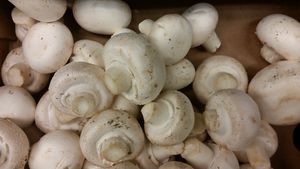 |
Mushrooms are easy to cook and are loaded with nutrients. It helps improve immunity in human body and can reduce cancer risk. I love pizzas with extra mushroom on it. | 1. What are the differences between white mushroom and brown mushroom? Why is brown mushroom often more expensive than white mushroom?
2. What kind of substrate do mushrooms grown on and what nutrients are required during cultivation? 3. Why do supermarkets often provide paper bags for mushroom particularly? What are the disadvantages of using plastic bags for mushroom? 4. Why is heavy metal a bigger problem in mushroom cultivation than other vegetables? 5. Is mushroom with inside (gills) turned dark still edible? What are the reasons that cause them to turn dark? Most of the questions above were not covered in FNH 200 course, so I googled for the answer and they were actually typical questions that people ask about mushrooms. 1. White and brown mushroom are different species. They have different taste and different ways to serve. There is no much info about the price between the two mushroom but from the "taste profile" of the two species, I suspect that the higher price of brown mushroom might be a result of its "more intense" flavor compared to white mushroom. http://www.mushrooms.ca/about/varieties.aspx (reference). 2. Mushroom grow on compost that is mainly composed of straw, other plant wastes and salts. Different types of mushroom require different temperature, levels of moisture and PH of the composts. https://www.youtube.com/watch?v=YgVAHKhkEAk (reference). Detailed information about how the white button mushroom shown on the picture is grown can be found from scientific papers from UBC library. 3. Paper bags are used for mushrooms to prevent them from drying out but unlike plastic bags, paper bags don't trap the water because it absorbs some moisture and allow for air circulation. http://lifehacker.com/5831132/use-brown-paper-bags-to-keep-mushrooms-dry-and-fresh (reference). 4. There are more research needed for the problem about heavy metal in mushrooms since different types of mushrooms contain different of heavy metals and our bodies respond differently to those metals. Specific cases about this problem can also be found on scientific research since they are generally done in laboratory. Web of Science and UBC library are good resources. 5. According to the Belly Bytes website ( http://www.bellybytes.com/foodfacts/mushroom_facts.html#.VxEQmjYrJsN ), dark grills means old age and it is better to avoid those mushrooms. |
| Mariana Navarro | 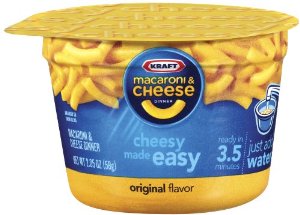 |
I love mac & cheese, it is delicious and also easy and quick to prepare. I think they are just as good as the ones I make at home. | 1. What makes this mac & cheese instant?
It’s instant because of the fact that you just have to add water and heat (microwave) and you have your food ready. 2. Is it real cheese I am eating? How is the cheese powder made? Yes it is real cheese, but it has been dehydrated through spray drying in order to preserve it. It may also contain more additives than regular cheese in order to have a longer shelf life, because spray-drying itself doesn’t kill microorganisms nor inactivates their enzymes. 3. Why do I have to add water in order to prepare it? How can the powder turn into cheese when water and heat are added? Water is used to rehydrate the product. In order to preserve the product, the pasta is dehydrated through an air-drying method, which consist of putting the food on trays and heating it hot air (60-80ºC). |
Family Names that Start with 'O'
| Your Wiki ID | Photo of the Food | Option A: What happened? Option B: Why Did You Select This Food? |
Questions You Have |
|---|---|---|---|
| Your Name | Photo and Caption | Why You Chose this Food? | Your Questions |
| Your Name | Photo and Caption | Why You Chose this Food? | Your Questions |
| Your Name | Photo and Caption | Why You Chose this Food? | Your Questions |
Family Names that Start with 'P'
Family Names that Start with 'Q'
| Your Wiki ID | Photo of the Food | Option A: What happened? Option B: Why Did You Select This Food? |
Questions You Have |
|---|---|---|---|
| Emily Park | 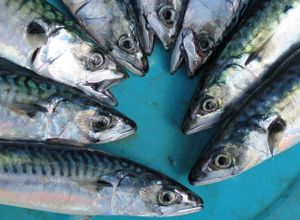 |
I chose mackerels because my mom and my brother have allergic reactions to this type of fish. The symptoms were reddish, itchy bumps all over their back. It happened ten years ago at home during a family dinner. This illness was resolved when they stopped eating mackerel. | My questions are: Is this allergic reaction to mackerels inherited from family?
- According to kidshealth.org/en/parents/allergy.html, the tendency to develop allergies is often passed down from genes. But just because a person's blood-related family have them, does not mean he/she will inherit them 100%. Why don't other type of fish cause allergic reaction to them? - This could be due to a reaction to high amounts of histidine found in scrombroid fish such as Mackerels. Histidine is then converted to histamine by active bacteria on dead flesh of Mackerels that can cause series of reactions such as reddish, and itchy bumps. (LESSON 12) |
| Lisa Popplewell |
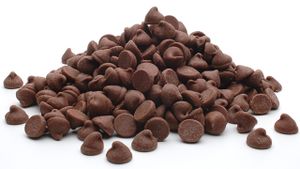 |
I chose chocolate because not a day goes by when I don't eat chocolate. I especially like chocolate chips because of their small, easy to snack on size. | 1. How do chocolate chips go from being a giant cocoa bean to the refined product I am used to seeing?
We did not talk about cacao processing in FNH 200. I think the cacao bean must be roasted to get the rich, dark colour of chocolate. I have read up on the processing, outlined below: Step 1. Cacao bean is roasted. Roasting brings flavour and aroma (Maillard Browning Lesson 2) Step 2. Outer shell is cracked + taken away leaving pieces of cacao beans - edible but bitter Step 3. Cacao nibs are grounds into a thick paste called chocolate liquor Step 4. Add sugar, cocoa butter, milk, vanilla to the chocolate liquor Step 5. Run mixture through a series of steel rollers to refine the texture Step 6. Chocolate tempered Source: http://facts-about-chocolate.com/how-is-chocolate-made 2. How do the chips get their chip shape (instead of a bar)? We did not talk about this in FNH 200 but I think it is due to different processing procedures between the bar and the chip. I think chocolate bars would be set in bar moulds while chocolate chips are “dropped” or piped onto a flat surface and left to set. 3. What is tempering and why is it important to chocolate processing? We did not cover this in FNH 200. I have read up on the tempering process, as follows: Tempering is the process by which chocolate is set to make it shiny and crisp. It is a specific set of temperatures and processes that must be followed, otherwise the chocolate will not set and will be “rubbery”. Blooming is when a white coating appears on the chocolate. This is due to a problem in the tempering process. It is caused by fat of sugar coming out of the chocolate (i.e. coming out of dispersion Lesson 2) and rising to the surface. Source: http://www.kingarthurflour.com/blog/2014/01/31/a-basic-guide-to-tempering-chocolate/ 4. What is the difference between adding vegetable shortening or milk solids to chocolate? Why choose one over the other? This was not covered in FNH 200. I have researched the subject, as follows: Vegetable oil and milk solids cause differences in the tempering process. Chocolate with vegetable oil is easier to set, while chocolate with milk solids tastes better. Chocolate made with vegetable oil is not technically chocolate as set by the standard identity of food (Lesson 4) and must be referred to as “candy” (i.e. candy melts). Source: http://www.kingarthurflour.com/blog/2014/01/31/a-basic-guide-to-tempering-chocolate/ 5. Does chocolate from different types of cocoa beans taste different? Why? While not covered directly in class I believe that just as different types of oranges taste slightly different so do different types of cacao beans. How the cacao bean is processed (like roasting) can also affects the overall flavour. |
|
Nishi Parikh |
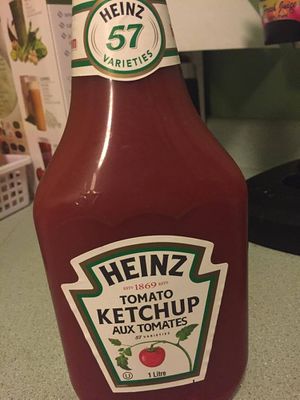 |
I chose Ketchup because it's one of my favourite table sauces and a commonly used condiment. I enjoy pairing ketchup with a variety of food ranging from fries to pasta dishes. Ketchup can be easily used to add flavour to almost any food and does not require any preparation. |
1. How is the acidity found in tomatoes reduced in ketchup? There are a lot of other ingredients added to ketchup which provide the sweet and sour taste rather than just a sour taste. Various sweeteners, salts and vinegars are added to the ketchup to help reduce the natural acidic flavour. http://www.madehow.com/Volume-2/Ketchup.html 2. What processing do tomatoes go through to get such a smooth texture? From looking at some online sources, it appears that tomatoes go through a pulping process which separates the skin, seeds and stems from the pulp. This pulp is filtered further to turn it onto the tomato like paste that we eat. 3. What preservatives are added to maintain the dark red colour? As we discussed in lesson 9, sometimes the presence of air and oxygen can cause undesired reactions to occur in foods. In the ketchup making process, all air is removed from the containers to avoid any reactions which cause discolouration and microbial growth. 4. Is there a preference for a certain type of tomato for ketchup? Though we have not discussed ketchup production specifically I would think they choose a type of tomato that isn't fully ripe yet and they also look for consistency between their tomatoes so that the taste of their brand is maintained. More information on what tomatoes are ideal can probably be found on company websites as well on cooking blogs with homemade ketchup recipes. 5. What are the differences in processing between ketchup, tomato jam and tomato puree? From what we have discussed in lesson 1 (the different levels of processing apple products go through), I think that tomato puree goes through the least amount of processing of the three as it's taste and texture are not completely different that of an actual tomato whereas the flavour and texture of ketchup and tomato jam are quiet different from tomatoes. |
|
Isabelle Philpott |
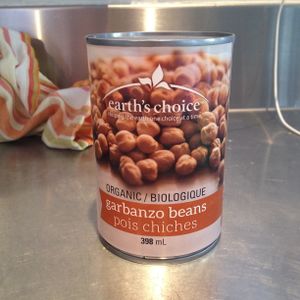 |
I chose Garbanzo beans because they are used frequently in my household for a variety of dishes. Garbanzo beans are a good source of protein without having to eat animal products. They are easy to keep in your cardboard since they remain good for a long period of time. |
1. How are they preserved? 2. What is the thick liquid that is in the can with the beans? 3. Is it necessary to wash the beans before using cooking? 4. How does canning work? 5. Does the process used to preserve the beans lower their nutritional value? 1.Chickpeas are preserved using commercial sterilization, specifically canning. This means that the chickpeas are put in a pre sterilized container that is then seal and undergoes a heat treatment to kill all the microorganism that cause food spoilage and illnesses. (Lesson 6) 2.I am guessing that the thick liquid in the can with the chickpeas is liquid that has come out of the beans over time while they have sat on the shelf. This is probably released as a result of the heat processing that they have gone through and it may be condensation mixed with the juices from the beans. 3.We did not discuss in class if it is necessary to wash beans before using them. I believe that, because of the process of canning it is not necessary to wash the beans. They would most likely be safe for consumption, since all the microorganisms are dead. The consumer therefore can make that decision depending on their personal preference. 4.Canning is a process where the food product is place into a sterile container then sealed. Then the sealed container goes through a treatment of moist heat of at least 121°c for a minimum of 15 minutes to kill off the microorganisms to ensure that it is safe to eat. This also allows the food to be store for a long period of time without it spoiling. (Lesson 6) 5.There will be quite a bit of the nutritional value lost, since the chickpeas are processed with thermal preservation. The chickpeas will be exposed to more heat for a lengthy amount of time, since the heat will be retained in the can. Only about 55% of their heat sensitive vitamins remain after canning, but they retrain a larger percentage of more heat resistant vitamins. (Lesson 11) |
| Your Wiki ID | Photo of the Food | Option A: What happened? Option B: Why Did You Select This Food? |
Questions You Have |
|---|---|---|---|
| Your Name | Photo and Caption | Why You Chose this Food? | Your Questions |
| Your Name | Photo and Caption | Why You Chose this Food? | Your Questions |
| Your Name | Photo and Caption | Why You Chose this Food? | Your Questions |
Family Names that Start with 'R'
| Your Wiki ID | Photo of the Food | Option A: What happened? Option B: Why Did You Select This Food? |
Questions You Have |
|---|---|---|---|
| Colin Rintoul | 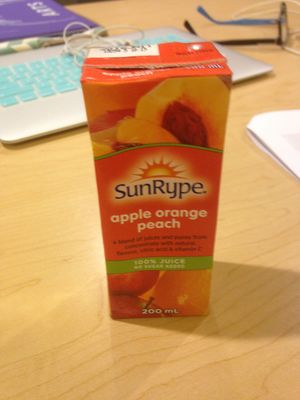 |
I selected this food because it's delicious, fast, and easy to bring with me. | Are boxes the best way to store juice?
Where are the fruits for juice boxes grown, and stored? How does consuming whole fruits compare to juice? Does the juice expire or the packaging? How does Juice compare to cocktail or "Drink"? 1.) As we learned in lesson 6 juice boxes are used for Ultra High Temperature Processing (UHT) of juice, in order to give them a shelf life of up to 6 months without refrigeration. UHT does not require the addition of any preservatives making it the best way to safely store juice at room temperature for extended periods of time. 2.) We did not discuss growing and storage locations for food products in FNH 200 but I’m sure each product differs in where its fruits are grown. However, we did discuss popular storage techniques like controlled atmosphere storage in which the pressure and gas concentrations are altered in order to prevent food spoilage (Lesson 1). 3.) Not discussed in FNH 200 specifically but in FNH 250 we learned that juice contains more sugar than consuming a whole fruit because of the lack of fibre preventing absorption. 4.) As we learned in lesson 6 the Juice packaging’s risk of being damaged increases with time especially for juice boxes which are at high risk of puncturing. Eventually there is a risk that the food inside will spoil especially with a deteriorating package. 5.) Not discussed in FNH 200, however, I would speculate that cocktails are usually sweetened with high fructose corn syrup or other sweeteners to make them sweeter but provides no added nutritional benefit. “Drink” is usually made from a blend of sugar and flavouring agents rather than any natural product. |
| Daniel Rodriguez | 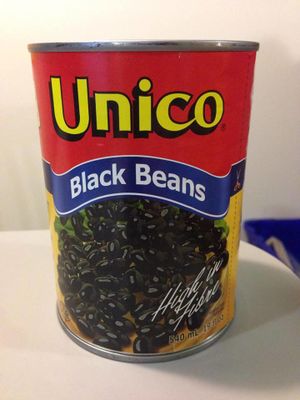 |
I chose this food because beans are an everyday food for me, they are delicious and nutritious. Canned beans are conveniently pre-cooked. | What thermal treatment does the product receive?
Is the nutritional value of canned vs home made beans significantly different? Does it need some kind of preservative? This product contains calcium chloride, what is that for? Does the nutritional value change over time? |
| Soraya Rizzo | 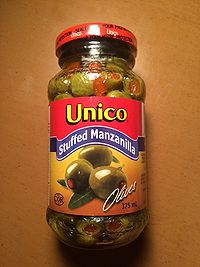
Stuffed Manzanilla Olives |
I chose olives because they are one of my favorite processed foods and growing up in an Italian household they were frequently consumed by our whole family. I still love to eat olives and I always have an extra jar ready in my cupboard. | 1. What are the ingredients that go into preserving a jar of olives?
A: We did not specifically talk about the ingredients that are used to preserve a can of olives, however we did talk about different preservation methods starting in lesson five and finishing in lesson ten. There are many different types of processing, such as thermal, low temperature, dehydration, ionizing energy, and various biotechnology techniques that we learned about. After learning about preservation methods in class, my best guess is that the ingredients that olives are preserved in are salty and acidic, as these conditions prevent microorganisms from growing. Furthermore, having the olives immersed into a water solution prevents aerobic organisms from living, as there is little oxygen available. According to wikiHow (http://www.wikihow.com/Cure-Olives), you can preserve olives through a water cured process where you soak the olives (replacing the water daily) and then place them in a brine mixture of pickling salt, water and vinegar that will both preserve the olives and give them a delicious pickled taste. Furthermore, there are other methods such as dry salt-cured, brine-cured and lye-cured olives. 2. Are all different types of olives processed and preserved in the same way? A: We did not talk in depth about olives or the different varieties of olives in class. My best guess is that all different olives require a similar preservation technique and would all be placed in a brine similar to the one mentioned in question one. The following source contains good information on the different types of olives and the different ways to preserve and store them: http://anrcatalog.ucanr.edu/pdf/8267.pdf. For example, this source states, “some olive varieties are preferred for specific olive styles, based on their flavour, texture, size, and processing characteristics. The Manzanillo variety is ideal for lye-cured olives and Spanish-style green olives, the Mission variety is excellent for dry salt cured ripe olives and dark ripe style or California black ripe style olives, the Kalamata variety is ideal for Kalamata-style water-cured olives, and the Sevillano variety is often used for Sicilian-style fermented olives.” I found that although the different types of olives have slightly different optimal storage and preservation methods, they are all fairly similar and they all use the basic methods stated in question one or a slight variation to it. 3. Is there a significant change in flavour and nutritional value when comparing a canned jar of olives to fresh olives picked off of a tree? A: We did not learn this information in class. However, after doing some research I found that olives that are picked off of a tree contain a very bitter compound called oleuropein. This is why it is important that harvested olives are processed and preserved through “curing” methods. This process removes the bitterness of the fresh olive in order to make them palatable and give them their unique delicious flavour. (information found from: http://anrcatalog.ucanr.edu/pdf/8267.pdf). 4. Is there a certain pH that olives must be stored at in order to give them their shelf life? A: As learned in class in lesson two, pH is important for the food industry. The important number to know is pH 4.6; this is the borderline between an acid food and a low acid food (acid foods have pH of 4.6 or less and low-acid foods have pH greater than 4.6). This is important knowledge, as acid foods will not support growth of disease causing microorganisms. It is my best guess after learning about pH in class and through my research on olives, that the solution used for preservation and storage of olives has an acidic pH. According to the source found at http://anrcatalog.ucanr.edu/pdf/8267.pdf, lye-cured non-fermented olives are low-acid foods. Additionally, it is important to be aware that olives canned improperly at home have caused botulism poisoning. As we learned in lesson six, Clostridium botulinum can grow in low acid foods in the absence of oxygen. 5. During what season are olives harvested in and do they then need to be further ripened? A: As we did not talk about this is class, I found information on this question through the following source: http://anrcatalog.ucanr.edu/pdf/8267.pdf. Olives are harvested at different stages of ripeness and as the olives ripen further they produce the different types. The stages are referred to as green-ripe, turning colour, and naturally black ripe. The first full sized mature green-ripe olives are ready to be harvested in California starting in mid-September. As the green olives continue to ripen, their colour turns from yellow-green to rose to red-brown and are considered to be at the turning colour stage. Naturally black ripe olives are allowed to ripen fully on the tree. They reach the desired dark red to purple or black stage of colour about three to four months after the green-ripe stage. Naturally black ripe olives are harvested in California starting in mid-November and continuing through December, depending on the variety, crop yield, region, and on weather conditions. |
| Erin Reid | 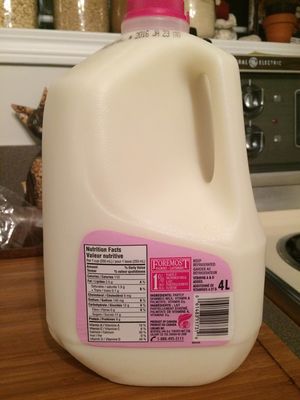 |
I chose milk because it is something myself and many people I know have on a daily basis, both on its own or combined with other foods (i.e. cereal or baking). | 1. How extensive, or how many steps are there to processing milk to make it the way it appears in a jug like this one shown?
2. Is there an ideal refrigerator temperature that milk should be kept at to best prolong it from becoming spoiled? 3. What chemical changes occur when milk is left out at room temperature that make it spoil? 4. How significant of a flavour difference is there between processed and unprocessed milk? 5. What ingredients are used to preserve milk? |
Family Names that Start with 'S'
| Your Wiki ID | Photo of the Food | Option A: What happened? Option B: Why Did You Select This Food? |
Questions You Have |
|---|---|---|---|
| Zoe Schmidt | 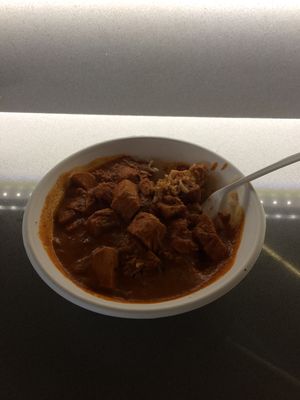 |
Butter Chicken is the one food I will always crave. I feel like I could eat it every day. I have never attempted to make it myself. This picture is of butter chicken served at the Delly, it's not my favourite, the consistency is a little off, but it'll do. | Why is it called butter chicken?! Is there even butter in it?! More scientific questions: What gives it the bright orange colour? ANSWER: The bright colour of the butter chicken comes from the many spices used, like turmeric, garam masala powder, cumin and red chilli powder. These are all highly pigmented spices that will colour any food dish. The dish can also be dyed to give the butter chicken its iconic bright orange colour that people associate with the dish. SOURCE: https://www.youtube.com/watch?v=-nzHXxasZ8E. What is so hard to replicate about butter chicken that the caned sauces taste nothing like the butter chicken you get at a restaurant? ANSWER: We never went over this in the course, also looking back it a very broad and not very good question. Here is a recipe for very authentic butter chicken that I am going to try and make http://www.colorandspices.com/2012/12/butter-chicken.html. What are the health benefits of having butter chicken with brown rice instead of jasmine rice? ANSWER: Brown rice has not been refined, meaning that the nutrients in the rice have been left intact. But white rice has been enriched with all the vitamins that it once possessed. Therefore both white and brown rice contains important nutrients but brown rice has gone through less processing. What parts of the chicken are usually used in butter chicken? How is that chicken processed? ANSWER: The chicken used for traditional butter chicken is usually thigh and legs and drum sticks, in more processed butter chicken like the one seen in the picture, it is usually pre cut pieces of white chicken meat. This chicken has probably been processed separately before being incorporated into the curry. What nutrients would I be missing if I only eat butter chicken for the rest of my life? ANSWER: We didn't cover this in this class. |
| Luisa Salimbangon | 
|
I chose honey because it has a sweet taste, thick consistency, and no expiry date. | 1. Why doesn't honey expire?
- I had to look up a bit of information about honey from http://www.compoundchem.com/2014/08/21/chemistryofhoney/ . From my understanding, with application to our lessons, honey doesn’t expire due to its relatively low water content of ~17%, which is supposedly lower than that of fungi and bacteria; low water activity of 0.6, which is below the general minimum for microbial growth at 0.75, and low pH of around 4, which makes it a low acid food. 2. What effect does pasteurization have on the chemical and physical properties of honey? - Pasteurization is done to remove any other microorganisms, such as [acid-tolerant psychrotrophic] yeasts, which supposedly, are stay able to survive in the honey. As yeast is added to some of our foods, i.e. beer and bread, it isn’t necessarily harmful. However, yeast is added to beer and bread to promote fermentation, and I doubt anyone wants fermented honey. (Lesson 09) 3. What are the differences between honeys produced from different flowers? - I don’t think we learned this in class, however this site: http://www.honey.com/honey-at-home/learn-about-honey/honey-varietals/ goes over honeys from different flowers – pointing out the unique flavours, colours, textures, and aromas coming from each. With any application to our lessons, I would assume that this would be tied to Lesson 04 and the grading standards for honey. 4. What are the differences between honeys produced from different seasons? - I’m almost sure that different seasons result in different honeys because of the different flowers that bloom all year round. Or maybe, colder temperatures would prompt sweeter honey as sugar is less susceptible to freezing than water (Lesson 07). Again, more information should come from this site: http://www.honey.com/honey-at-home/learn-about-honey/honey-varietals/ . 5. What chemical reactions occur in honey when it's cooked/heated? - Like with pasteurization, heating honey should kill of surviving microorganisms. In addition, since honey is known to contain bee enzymes, I would presume that they would denature from the heat. Heating can also melt/re-liquify crystallized honey. |
| Yasaman Sairafi | 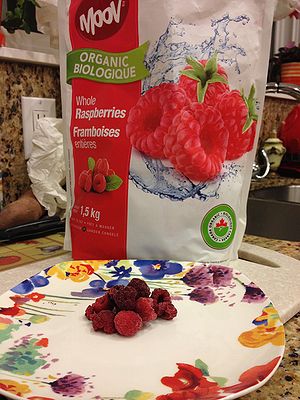 |
I chose frozen raspberries because they are actually cheaper than fresh raspberries and they last longer before rotting. Frozen raspberries are also nice because I’m able to consume them year-round. | 1. When do processors decide raspberries are at their peak and ready to be frozen? I read that Raspberries should be picked at their peak ripeness and we learned in lesson 7 that once raspberries are frozen, chemical reactions slow down and therefore nutrients can be conserved for longer. I also read that ripe berries are large, plump, deeply coloured and easily slip off the stem. (Lesson 7 and http://www.todayshomeowner.com/how-to-pick-wild-blackberries-and-raspberries/)
2. What kind of processing do raspberries go through after they are washed and before they are frozen? Raspberries must be dried before they are frozen. This probably helps with the formation of smaller ice crystals during freezing. (lesson 7) 3. Why exactly are frozen raspberries cheaper than fresh ones when the benefits to frozen are said to be higher (i.e longer nutrient lifespan)? I read that most frozen berries are imported from other countries, therefore they are bought for cheaper and can be sold for cheaper. Whereas fresh berries are usually picked locally. (https://www.quora.com/What-should-one-be-aware-of-when-buying-frozen-berries) 4. How are nutrients conserved when raspberries are frozen? (i.e what kind of chemical processes take place?) We learned that freezing slows down chemical reactions and enzymatic activities. Water activity is also reduced therefore the quality of the raspberries are persevered. (Lesson 7). I also learned that Raspberries are picked and frozen when they are at their nutrient peak. (http://www.livescience.com/35648-fresh-veggies-frozen-canned.html) 5. Are there any downfalls to consuming frozen raspberries vs fresh? We learned that if freezing is not done properly, it can result in rupture of the cell walls. Also if not done properly (at optimum temperature for the food) then it can cause changes in appearance, texture, flavour of the food (lesson 7). I also read that freezing foods are obviously more processed that fresh foods and are imported from other countries, so therefore there is higher potential for viral contamination. eg. Hepatitis. (https://www.quora.com/What-should-one-be-aware-of-when-buying-frozen-berries) |
| John Schirf | 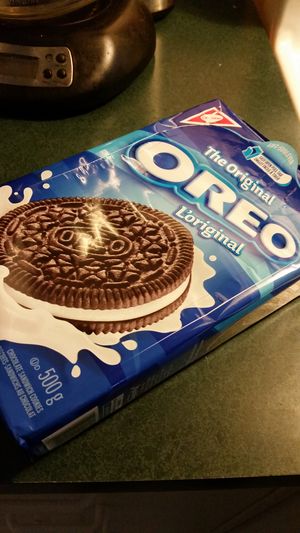 |
I chose this product because Oreos are a sweet, sugary treat that pair perfectly with milk. They are also a perfect food to binge eat for late nights or to toss one or two into a sack lunch. | 1. Is there any artificial coloring in the cookie part of an Oreo?
2. Why is the creamy center soft even after weeks on the shelf? 3. What is the purpose of palm oil in the Oreo? 4. How is it that Oreos can have a creamy "milky" center, yet still be vegan? 5. Oreos are salty, how important is salt to the composition of cookies or cream center in this cookie and other baked goods? |
| Michaela St. Cyr | 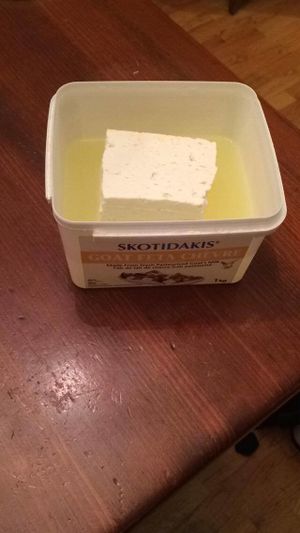 |
I chose feta cheese because it is one of my favorite types of cheese, that I use frequently in many different recipes, such as my favorite dish, Greek salad. Although I eat it quite often and really enjoy the taste, I wonder exactly how it is made and how it is processed. | 1. What happens (biologically) to the cheese when it expires?
2. Why does it have indents and holes in it? 3. What is the liquid that the cheese is kept in, and why does the cheese need to be kept within it? 4. What is added to the liquid that helps preserve the cheese? 5. What is in the cheese that makes it so crumbly?
2. Cheese is a fermented food, in which “good” bacteria is used to help add the distinct flavors to the cheese (Lesson 9). The holes in the cheese are called “eyes” and are due to the use of Propionibacterium shermanii as part of the starter culture. This bacteria produces propionic acid and carbon dioxide from lactic acid, which causes this hole formation in the cheese. 3. This liquid that the cheese is stored in is called brine. The purpose of the brine is to preserve the cheese. It preserves the cheese as it quite acidic which helps prevent spoilage from occurring. Furthermore, the brine keeps the cheese moist and prevents it from drying out too quickly, which thus extends the shelf life of the cheese. The brine is also involved in the curing process of feta cheese. http://tipnut.com/feta-cheese/ 4. This brine is composed of salted water, also known as whey. This whey (Lesson 9) allows the cheese to be moist and have a salty taste. In many types of cheese, the whey is drained, however, with feta cheese, it is not. Whey consists of whey proteins, water-soluble vitamins, some calcium and phosphorus, water, lactose, and lactic acid. 5. Although not mentioned in class, the cheese can be made to be firmer and thus more crumbly by soaking it in cold, salted water for a short period of time. On the other hand, depending on personal preference, the cheese can be made softer by setting it in warm water for approximately a minute. http://tipnut.com/feta-cheese/ |
| Braeden Sykes | 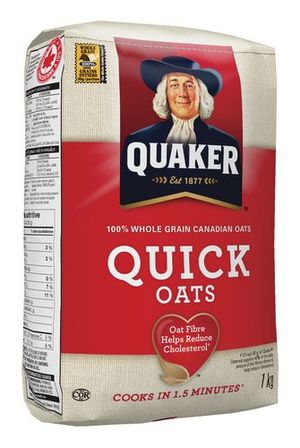 |
I chose this food because i eat quaker quick oats almost every morning because they are fast, easy to make, low in sugar, and high in dietary fibre. | 1. How are the oats processed from their original ingredients ?
the original whole grains are first steamed or pre cooked to remove certain microorganisms and spoilage enzymes. after this they are dehydrated and rolled into their flake oat shape. dehydration of the oats also allows for a long shelf life of the oats due to low water activity. Lesson 8 2. What makes quick oats different from regular oats ? instand oats are the most processed type of oats where they are rolled out thinner than other varieties of oats so they can be cooked faster by absorbing the water more rapidly. this causes different textures between the different kind of oats depending on how processed or rolled they are. Lesson 5 3. What is the difference between the soluble and insoluble fibres in quick oats ? Soluble fibers in the oats attracts water in the GI tract and makes for slower movement of nutrients through the digestive system. also bacteria in the large intestine ferment this type of fiber and produce gases. Insoluble fibers makes food go through the GI tract faster and adds bulk to stool for a more healthy GI tract. FNH 250 4. Are oats that are sold in bulk healthier than quick oats? No they all contain the same nutrient content but depending on how much they have been processed there may be different preservatives added during processing and different textures caused by the different amounts of processing. Lesson 5 5. Do quick oats have an expiry date? Oats may eventually have an expiry date but due to their low water activity and content there shelf life is longer than 90 days so they are not required to have an expiry date. Lesson 4 |
| Isabella Scandiffio |  |
I got salmonella poisoning when I was 17 years old after consuming an omelette from a diner in my hometown. Within hours after consuming the contaminated food, I began experiencing common symptom of Salmonella poisoning (i.e., vomiting, diarrhea, fever, and abdominal cramps) after several days of symptoms, I was then treated and hospitalized for severe dehydration. | 1. Does cooking kill Salmonella? In lesson 12 we learned that Salmonella are easily killed by heat (normal cooking and pasteurization processes) and ionizing energy, but survive freezing and dehydration.
2. How does salmonella spread? People become infected with salmonella by swallowing the bacterium. This can happen from eating contaminated food that has not been completely cooked, or has been contaminated after preparation. Salmonella can also be spread from person to person when an infected individual does not thoroughly wash his or her hands after using the toilet. (http://healthvermont.gov/prevent/salmonella/Salmonella.aspx) 3. Is eating restaurant food riskier than cooking at home? Because you have more control over the food you prepare at home, if you practice safe food handling while preparing meals, you are probably less likely to contract a food borne illness at home. (http://www.foodborneillness.com/food_poisoning_faq) 4. In what food is Salmonella most commonly found? In lesson 12 we also learned that raw meats and poultry, eggs (about 60% of chickens sold in the retail market are contaminated with Salmonella), milk, dairy products. 5. Are there different types of Salmonella? The three main types of Salmonella enterica are Typhimurium, Enteritidis, and Typhi. S. Enteritidis has become the single most common cause of food poisoning in the United States.(http://www.salmonella.org/info.html) |
| Pedro Henrique Sima Alvares | 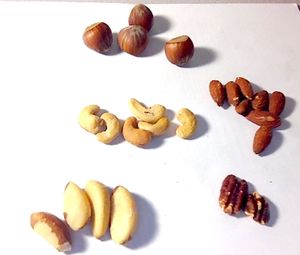 |
I chose nuts because I follow a fairly strict diet, in which I try to eat as few carbs as possible and have free intake of fats and protein. Nuts fit perfectly in this diet, so I eat them almost everyday and enjoy all kinds of nuts. They also serve as good substitute for unhealthier snacks. | 1. What are the main differences between each nuts' nutrition facts?
2. Which nut has the lowest carbohydrate content? 3. Can you make butter from any kind of nut? 4. Is there difference between pre-cracked nuts and nuts in the shell? 5. Which nut tastes the best and why is it Hazelnut? |
| Akshdeep Sandhu | 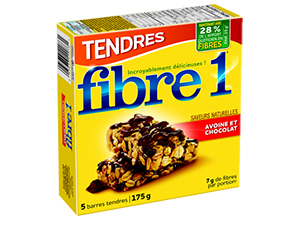
|
I chose this because i often find myself not having enough time to have a proper breakfast, so I usually snack on fibre 1 bars. | 1. What exactly is fibre?
2. How is this particular bar able to have so much more fibre compared with other granola bars? 3. Are there different types of fibres? 4. Are certain types of fibres better than others? 5. Why is fibre so necessary in my diet? |
| Jennifer Siu | 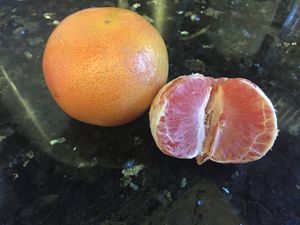 |
I chose grapefruit because I love having it in the morning for breakfast. I usually will have at least half a grapefruit for breakfast almost everyday | 1. How does the citric acid help this fruit keep longer than other fruits?
2. Exactly how much longer on average can a grapefruit still be edible compared to other non citrus fruits? 3. What makes the skin so much more bitter on grapefruit compared to oranges 4. Why is it such a common breakfast food? 5. What kinds of benefits are there to eating grapefruit in the morning vs. eating it later at night? 1. The citric acid has a pH below 4.6 (Lesson 2), which is the ideal pH in which growth of microorganisms is not supported. According to the US Food and Drug Administration, grapefruit has a pH of about 3-3.75, meaning that it is well below 4.6, and is considered a high acid food Source: http://www.foodscience.caes.uga.edu/extension/documents/fdaapproximatephoffoodslacf-phs.pdf 2. We did not discuss the exact shelf life of oranges and non-citrus fruits, although we did talk about how apples can be stored for a long time under a controlled atmosphere and temperature. My educated guess would be that, at room temperature citrus fruits would store a few more days than non-citrus fruits. Citrus fruit shelf life would also be greatly extended by refrigeration in which the growth of microorganisms are slowed down (Lesson 7). 3. Grapefruit contains narigin which gives it the bitterness that it has. Naringin is a flavinoid that is present in citrus fruits, but especially in grapefruit, which explains why grapefruit is much more bitter than a typical orange. Source: http://www.wholehealthmd.com/ME2/dirmod.asp?type=AWHN_Supplements&id=BEDFFBD34E734949B5CE53E3A20627D8&tier=2 4. Grapefruit contains another flavinoid, nargenin, which has shown to reduce insulin when consumed before a meal. This means that food is used for energy instead of being converted to fat. So it would make sense to consume grapefruit before a meal, and perhaps it is consumed mainly in the morning in order to curb appetite for the rest of the day. It is also full of fibre which will keep you full. 5.There seems to be no scientific research to back up as to whether grapefruit is more beneficial to eat in the morning compared to eating it at night. By convention, grapefruit has simply just become a breakfast food that people generally eat in the mornings. |
Family Names that Start with 'T and U'
| Your Wiki ID | Photo of the Food | Option A: What happened? Option B: Why Did You Select This Food? |
Questions You Have |
|---|---|---|---|
| Tania Talebzadeh | |
WHY I CHOSE THIS? -I absolutely adore Persian yogurt, because I can add it to my cake mix, make various sauces out of it or just simply add some nuts and spinach to it (as a little snack). I use around one bucket of yogurt per week, as I grew up using it in basically anything and everything I eat (either beside my main dish or directly including it within the main dish). | QS.
1) What are the chemical reactions that take place when plain yogurt starts tasting sour after about a week? 2) Is there a signifiant difference (nutritious wise) between low-fat yogurt and a high-fat yogurt? 3) How does the process of yogurt-making occur- what chemical reaction occurs when you make milk into yogurt at home? 4) How do we make some yogurts gluten free?- What is the process? 5) Do we only add gelatin to yogurt to make it more stiff/ solid? Answers: 1) I am guessing that when yogurt goes sour it is because of the high volume of active bacteria & microorganisms! Site used: http://www.foodrepublic.com/2011/11/22/why-does-yogurt-taste-sour/ . To prevent this for happening, we can place the yogurt in cold temperatures to prevent the effects of growing microorganisms (the fridge). This allows the yogurt to go sour at a later date. 2) I am guessing that the only huge difference is in the type of milk that is used to produce the yogurt. Extra ingredients are usually added to the low-fat yogurt to make up for the undesirable taste of low-fat milk being used! Site used: http://www.livestrong.com/article/444387-low-fat-yogurt-vs-no-fat-yogurt/ . It is also a necessity in labeling (Lesson 4), to show what % milk fat that is utilized. 3) This was not necessarily in lecture notes, but was spoken about in class! When we spoke about different ways people learn how to make things at home (learn from passed down recipes & such)! The short answer is that yogurt is what happens to milk when bacteria get into it & reproduces itself (the process is lengthy when my mother and I make it at home!). Here is a site that explains how it’s made & how to do it: http://www.thekitchn.com/how-to-make-yogurt-at-home-cooking-lessons-from-the-kitchn-125070 4) We have not covered this, but since plain yogurt is made with milk that's been fermented with friendly bacteria! In its pure form, yogurt is gluten-free unless some sweeteners & flavours are added! Site used: http://celiacdisease.about.com/od/GlutenFreeSnacks/a/Gluten-Free-Yogurt.htm 5) This has not been covered, but I am guessing that other than Gelatin, Pectin and Agar can sometimes be used to thicken yogurt as well (especially if it’s homemade). Site used: http://www.culturesforhealth.com/thickening-homemade-yogurt
|
| Jessica Tran | Smoked Oysters 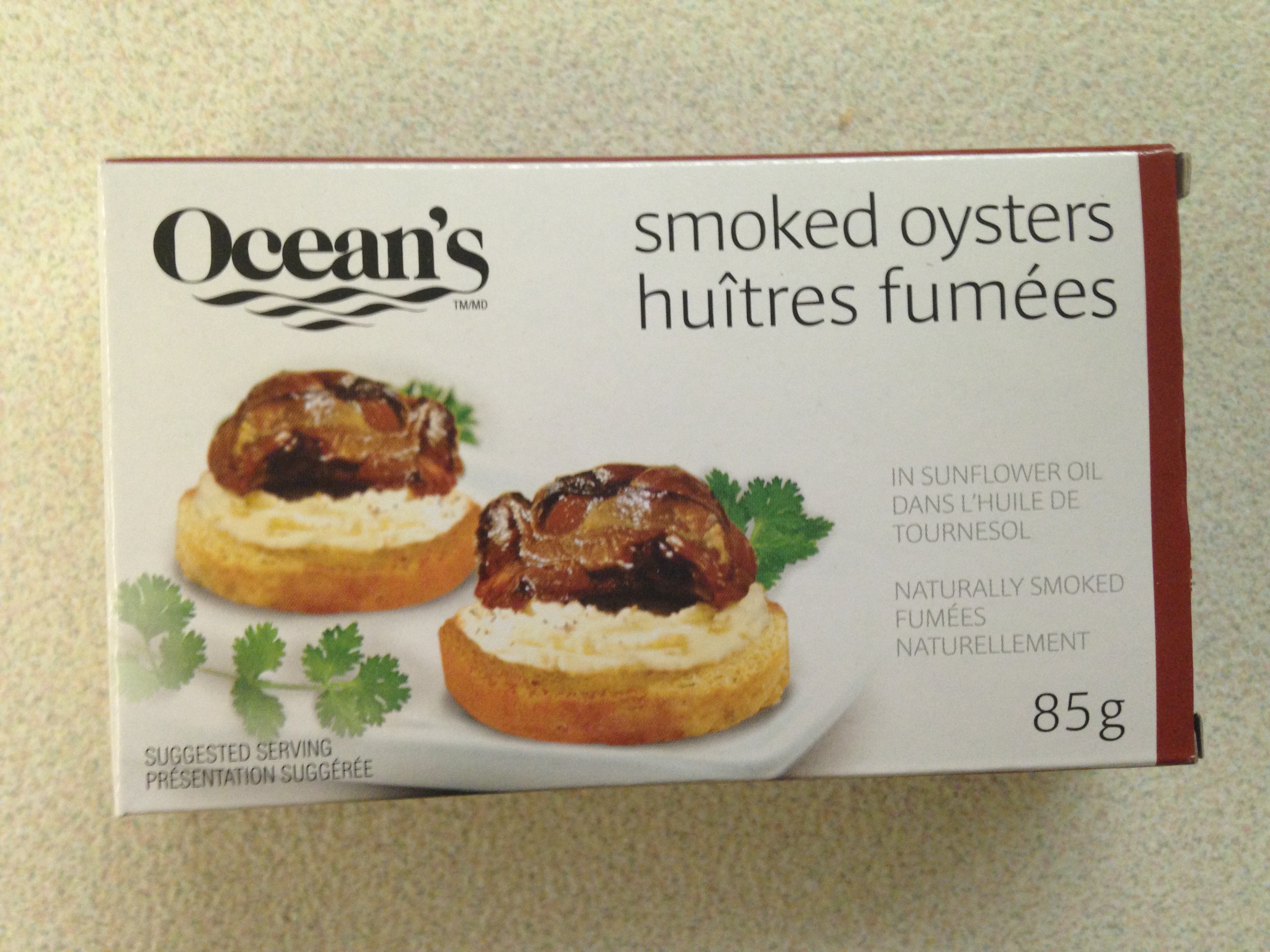
|
I chose this product because it is quick, easy to pack, and delicious to eat with cheese and crackers. | 1. What were the steps to smoking oysters and packaging?
http://chickenofthesea.com/company/know-your-seafood/oysters - Smoked: Goes through a smoking process under controlled time and temperature conditions - Thermal Processing: sealed cans are cooked under pressure utilizing process time and temperature schedules designed by processing experts commercially sterile all aspects of thermal processing are strictly monitored and controlled - Thermal processing involves the application of heat to inactivate enzymes and destroy microorganisms type of thermal processing: Commercial Sterilization - Commercial Sterilization: "means the condition obtained in a food that has been processed by the application of heat, alone or in combination with other treatments, to render the food free from viable forms of microorganisms, including spores, capable of growing in the food at temperatures at which the food is designed normally to be held during distribution and storage” - Canning: Canning involves heating the food with a minimum treatment of 121°C moist heat for 15 minutes.The process usually involves pre-sealing the food in containers prior to heating. Canning can be traced back to the early 1800's. It is called the"botulinum cook” - Steel body cans with a thin layer of tin ('tin cans") are the most widely used containers. They withstand high temperatures and pressure differentials and are not readily breakable. The can lids provide a good indication of the presence of a vacuum and thus a hermetic seal (a seal that is impervious to the transmission of gases, water and microorganisms). The steel, and very often the tin plating, must be protected with lacquers to minimize reaction of the metals with food constituents. - Cans can be made with easy open features. Some have hinged covers or slip-on covers for easy access.
3. What happens to the oyster while it soaks in sunflower oil? - fat makes food more palatable and easier to chew and swallow - carriers of many aroma constituents in food they are usually fat-soluble - fat contribute to the overall flavour of food 4. Why sunflower oil? and not another type of oil? - Sunflower is monounsaturated (MUFA)/Polyunsaturated (PUFA) mixture - Improve health boost polyunsaturated fat might help lower your cholesterol levels, which can decrease your risk of cardiovascular - Even though the sunflower contains more fat, its mostly healthy - Helps with the distinctive taste 5. “Source of Omega-3 Polyunsaturates” but what does that do for us? https://en.wikipedia.org/wiki/Omega-3_fatty_acid - The link above was a suggested reading in Lesson 2 about Fats - Fatty acids - Body can’t make them ourselves - Found in fish - Play important role in brain function and normal growth development - Aka polyunsaturated fatty acids (PUFAs) - Risk of heart disease |
| Your Name | Photo and Caption | Why You Chose this Food? | Your Questions |
Family Names that Start with 'V'
Family Names that Start with 'W'
| Your Wiki ID | Photo of the Food | Option A: What happened? Option B: Why Did You Select This Food? |
Questions You Have |
|---|---|---|---|
| Simiao Wei |
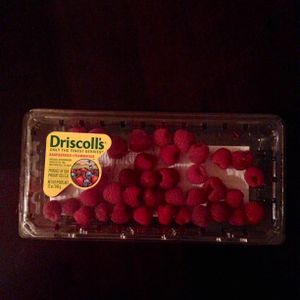
|
Raspberries are low in calories, are easy to prepare, nutritionally dense and taste like tiny sugar bombs. |
Answer: Driscoll says that they “handpick and field pack" their raspberries. They recommend washing them before consumption so I assume they are not washed after since they say contact with water decreases shelf life. After packaging the berries are stored in a controlled atmosphere storage facility with suitable oxygen content, temperature and light intensities. They are then transported by land in trucks with a controlled atmosphere. Wet batches are likely due to temperature fluctuations when the berries are transported location to location (storage to truck, truck to retailers).
Answer: They are probably grown in fields since California's coast has a mild temperature. Raspberries typically grow well in mild temperatures around 21 C so I assume their year round availability is attributed to California's natural warm climate.
Answer: Packaging for fresh fruit requires a container that allow the fruit to respire, absorb excess moisture (the sheet at the bottom of the container) and has enough structure so the fruit does not get damaged during storage and transportation. Since consumers like to see their food before purchasing, a compostable packaging should be a clear packaging. Containers made from corn, sugarcane patented plant-based clear plastics are available but can be of a higher cost. It is a possibility if there is enough demand.
Answer: The raspberries are probably packed in cardboard boxes and transported. Many retailers have the producer’s products in a cardboard box.
Answer: Growth conditions do not affect the colour intensity, but storage conditions do, as anthocyanin levels increase as pH of the fruit increases. Robbins and Moore (1990) found the fruit became darker, less red and more blue, the rate dependent on temperature. Raspberry flavour is mostly impacted by biological variations, climate, soil, ripeness (Aprea et al. 2015). Soil pH and nutrient content probably effects how well the berries develop. Citations: Robbins, JA.; Moore, PP. (1990). Colour Change in Fresh Red Raspberry Fruit Stored at 0, 4.5, or 20 C. HortScience, 25 " (12), 1623-1624. Aprea et al. (2015). Volatile Compounds of Raspberry Fruit: From Analytical Methods to Biological Role and Sensory Impact. "Molecules, 20" (2), 2445-2474. doi: 10.3390/molecules20022445
|
| YuHsuan Wu (Michelle) | 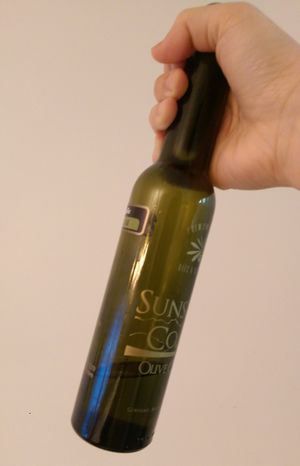 |
I chose olive oil and what I like about it is aroma and convenience during food preparation such as making salads. | 1. Some olive oil come in darker containers while others do not. How might packaging have an effect on the product?
From Lesson 5, we learn that light can promote oxidative deterioration in food products, especially oil based products. Storing olive oil in a dark container can decrease the rate of oxidative rancidity and extend the shelf life of the product. 2. What does the process of making olive oil involve? The process of making olive oil involves grinding the fruit after harvest and applying pressure to force out and collecting the oil. The whole process must not be higher than 27 degrees Celsius if it were to be cold pressed. For more information visit the link: https://www.youtube.com/watch?v=aieNV3V4b_s 3. What are the differences between different types of olive oil (eg. Virgin, extra virgin…etc.) There are several types of olive oil, including Virgin, Extra Virgin, Ordinary Virgin and Refined. According to the International Olive Oil Council, the main indicator for olive oil quality is the level of oleic acid present in the product. Extra Virgin olive oil has the lowest level of oleic acid, followed by Virgin and then Ordinary Virgin. Definitions and olive oil grading standards is found on: http://static.oliveoiltimes.com/library/ioc-olive-oil-standard.pdf 4. How does the shelf life of olive oil compare to those of other oils and fats? From the readings, we know that the more double bonds are present in fatty acids (unsaturated fatty acids), the earlier it is to develop oxidative rancidity. Oils such as canola oil and grape seed oil have higher levels of unsaturated fatty acids compared to olive oil, therefore have a relative shorter shelf life. Coconut oil and butter, on the other hand, have a longer shelf life due to having lower unsaturated fat contents. (http://preparednessadvice.com/food_storage/shelf-life-cooking-oils/#.Vw_Y_vmDGko) 5. How can olive oil be infused with different flavours? Infusing flavours into olive oil involves heating the oil along with a desired ingredient (garlic or herbs) at low heat to help release the aroma while eliminating harmful microorganisms. Then the mixture can be transferred to a sealable container for storage. (https://www.youtube.com/watch?v=8VvCjph16Yw) |
| Ilan Wright | 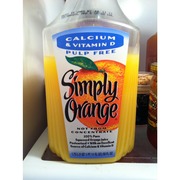 |
I love orange juice and this is considered a"premium" product I would say in comparison to some other brands of OJ. I'm curious though, it might taste better but is it really that different? | 1. Why are calcium and Vitamin D in some OJ? I know its optional but the one without was out of stock. If people drink this and milk perhaps they would get too much of the vitamins?
Answer: Calcium and Vitamin D are fortified in some orange juices. This means that these nutrients were not existing in the product to a significant degree, but were added during processing. This done to improve the nutritive value of the juice. Also, Vitamin C (found naturally in orange juice) is known to increase Calcium absorption so added calcium is a benefit to the consumer. 2. How "fresh" is this OJ really? Its been pasteurized, and stored on tanks before packaging. Answer: "Shelf stable" juices have been pasteurized to prolong shelf life and destroy pathogens. Processing can take a variety of different times. In regards to storage of the product, it is unknown how long this may happen for, but temperatures, atmospheric compositions, and types of storage containers are likely considered to preserve quality. 3. What does it mean to be "100%" juice? Answer: The government of Canada does not define the term 100% juice, but it does clearly set out strict guidelines for the parameters of orange juice quality and ingredients. Check it out!! http://laws.justice.gc.ca/eng/regulations/C.R.C.,_c._870/page-59.html#h-87 4. Should I be concerned that Coca-Cola, a soft drink company is in the juice business? Answer: This cannot truly be answered objectively. Large multi-nationals control large major parts of our food system. That is just a reality. 5. How are oranges graded? Sweetness, juiciness, who sets these standards? Answer: Similar to the way orange juice is defined by the canadian government, whole oranges have parameters that describe expectations in quality. Fruits are graded into Canada Choice, Canada Extra Fancy, and Canada Fancy. This designation is used for Canada. Considering oranges do not grow in Canada they are subject to imported fruit quality standards
|
| Po-I (Brian) Wu | [[File:Chocolate croissant.jpg|thumb|Chocolate Croissant] | I love chocolate croissant because it is flaky and buttery outside but soft and sweet inside with layers . It is a processed food and it tastes differently for each different local bakery. | 1. I want to know why the croissant can be made to be crunchy outside and soft inside?
2. What is the expiry date for a chocolate croissant? 3.What kind of ratio between chocolate and croissant can make the best combination of chocolate croissant? 4. Why does a croissant has so many layers? 5. What it has to be crescent shape? For question #1, I am guessing that it is because the dough was baked and baking can be a way to remove water from the original dough (Lesson 06). I can assume it must have something been to do with the rehydration rate of the dough since the continuous refrigerating is a process of making croissant and baking is the final touch that makes the croissant crunchy outside and soft inside. (Lesson 06). 2. Many factors can contribute for food spoilage (deterioration) (Lesson 5). Expiry date for a chocolate croissant is to let customers know that when the bakery product will mold and become unsafe to eat. On shelf, chocolate croissant expiry date is 1 day, 7 days for refrigerator, and 2 months in freezer. (storage session in Lesson 06). 3. We talked about chocolate croissant in class on Monday, January 18. We didn't really get into the topic of the ratio between chocolate and dough. But I remember Judy, the professor, said that if we are interested about how to make chocolate croissant, just search the recipes on the internet and watch the youtube about the ingredients and baking instructions. 4. The reason why chocolate croissant have so many layers is because the dough needs to be folding multiple times to come up with many layers. Also, it has to do with foaming (Lesson 4). "Solid foams such as meringue are formed when the whipped egg whites are heated causing the protein to denature and form a more rigid three-dimensional structure, which won't collapse when the air escapes" (Lesson 04). Croissant is an example of solid foams. 5. We never talked about this in class. It has something to do with "history of the croissant". According to online research, the reason why croissant is in crescent shape is because back then "the military collapsed the tunnel in on the Turks and eliminated the threat, saving the city. The baker baked a crescent shaped pastry in the shape of the Turk’s Islamic emblem, the crescent moon, so that when his fellow Austrians bit into the croissant, they would be symbolically devouring the Turks." - wikipedia. |
| Yi
Wang |
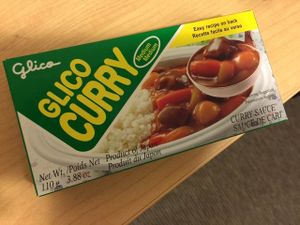 |
Curry is one of my favorite sauce, I usually mix it with rice and potatoes.The favor of curry is fantastic. | 1.How does the original form of curry preserved in room temperature?
Answer:I think the powder of curry should be heating to remove the water inside,and the rehydrated curry powder can be preserved in the room temperature.(lesson 8) 2.What should producers use to store curry bars? Answer:The plastic material like plastic cans or bottles would be good choices, because those materials are sterilized before and can be sealed properly. (lesson 6) 3.Why does curry make some people get inflamed? Answer: This might related to the ingredients of the curry spice, some people who have allergy to curry may associated with pollen-food allergy syndrome. The detail in (Yagami, A., Nakazawa, Y., Suzuki, K., & Matsunaga, K. (2009). Curry spice allergy associated with pollen-food allergy syndrome and latex fruit-syndrome. Journal of Dermatology, 36(1), 45-49. doi:10.1111/j.1346-8138.2008.00584.x). 4. What ingredients or processing methods are used to make curry? Answer: The ingredients of curry contain oil, fat and sugar substitutes, which give curry more texture and aroma.(lesson 3). They would add some other food additives as well. The processing method they use might be heating method which can eliminate the bacteria and prevent losing its original flavor. 5.Why should curry bars be vacuum sealed? Answer: To prevent the curry bar from moulds, most of them would be the agents of food spoilage and some can also produce toxins (mycotoxins) under favorable conditions, which are harmful to human beings.(lesson 5) |
| Nicole (Hon-Sze) Wong | 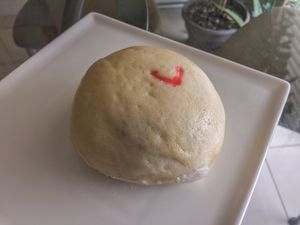 |
I chose this food because I find myself craving carbs a lot. Steamed buns have the perfect fluffy carbohydrate texture that I enjoy. I find these at the local asian supermarket or bakery but there is never any nutritional information about it. | 1. What is the shelf life of these steamed buns?
2. Why do I find myself craving a lot of carbs? What makes these buns so satisfying for my craving? 3. What are the ingredients needed to make a steamed bun? Where are the ingredients sourced from? What is the nutritional content? What makes it so fluffy? 4. Why do we steam steamed buns instead of baking it? Why is it the preferred cooking method? 5. Why are the vegetables in this bun preferred over others? How much of the daily vegetable intake is met in one bun? |
Family Names that Start with 'X'
| Your Wiki ID | Photo of the Food | Option A: What happened? Option B: Why Did You Select This Food? |
Questions You Have |
|---|---|---|---|
| Your Name | Photo and Caption | Why You Chose this Food? | Your Questions |
| Your Name | Photo and Caption | Why You Chose this Food? | Your Questions |
| Your Name | Photo and Caption | Why You Chose this Food? | Your Questions |
Family Names that Start with 'Y'
| Your Wiki ID | Photo of the Food | Option A: What happened? Option B: Why Did You Select This Food? |
Questions You Have |
|---|---|---|---|
| Cindy Young | 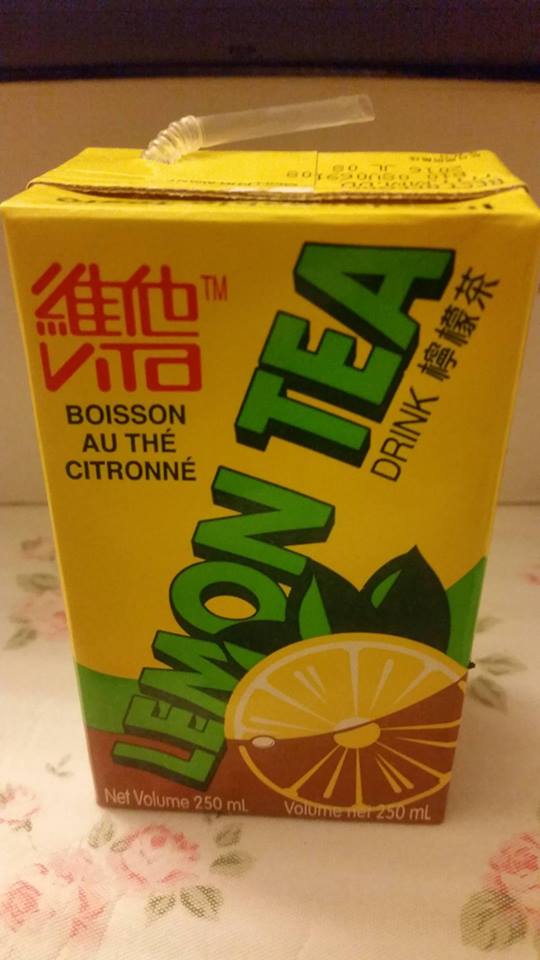
|
I personally enjoy sour foods so I chose lemon tea because I grew up drinking it so it brings back a lot of memories. It also tastes good whether it is at room temperature or in the fridge which makes it really easy to store. | 1). What makes the drink have a long shelf life of more than a year?
2). The nutritional facts table says one carton contains 50% of Vitamin C for the daily value, does this mean it is healthy? 3). Why are ingredients like "ascorbic acid" or "sodium citrate" added? What does it do? 4). When this product is sold, it is stored and displayed at room temperature. Does differences in temperature affect the taste or spoil the drink? 5). The drink is high in the sugar content (34g), is there a way to lower the sugar content by still keeping the same taste? 1) These products are called shelf-stable when they have a durable life date of more than 6 months (Lesson 5). Upon further investigation of the ingredients list, the additives such as citric acid and sodium citrate act as preservatives to improve the shelf-life (Lesson 4 and Health Canada website). 2) We were not taught much about how to read the nutrition facts table. My guess is that it is not the best way to achieve your daily intake levels for Vitamin C because of the high sugar content. Upon my spare time, I can find the answer on how to read nutrition facts table on the Health Canada website under Nutrition Labelling. 3) Adding on to my question from #1 and #2, sodium citrate acts as a preservative and ascorbic acid is used as an antioxidant and adds vitamin C to foods (Lesson 2). This explains the 50% DV value of Vitamin C in the drink and the long shelf life. 4) Temperature could affect the taste of the drink but I have to research more on how. I think I can find the answer in this journal: Green, B. G., & Nachtigal, D. (2015). Temperature Affects Human Sweet Taste via At Least Two Mechanisms. Chemical Senses, 40(6), 391-399. Fluctuations in temperature could spoil the drink because there are different pathogenic microorganisms that can survive in different temperature ranges. Although I am not sure if they can thrive because this is an acidic foods, few pathogenic microorganisms can grow in acidic environments as mentioned in Lesson 6. 5) There are a lot of low-caloric sweeteners and non-caloric sweeteners. But if we want to decrease the sugar content while maintaining a similar taste, using the non-caloric sweetener sucralose is the best method. It has a similar taste to sugar and does not increase blood glucose or insulin levels. (Lesson 3) |
| XinYue |
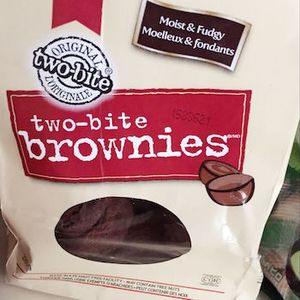 |
I personally love this food because its' smooth shiny texture. Chocolate scent mingled with lave is exquisite. Further more, you could easily get access to them in any groceries stores. | 1)What is the calories for one serving of brownies?
2)Are there any real rich chocolates added when processing? 3)What makes the brownies stay good in room temperature without an air-tight container for a month? 4)Is it a shelf-stable product? 5)Can we make gluten-free brownies while still keeping its good taste? For question
protein: 1 gram = 4 calories Carbohydrates: 1 gram = 4 calories. We could calculate the calories from reading the ingredients label. https://www.google.ca/url?sa=i&rct=j&q=&esrc=s&source=images&cd=&cad=rja&uact=8&ved=0ahUKEwjrxIznzZHMAhVR5mMKHTJbAhsQjhwIBQ&url=http%3A%2F%2Fwww.bodyrock.tv%2Fposts%2Fgluten-free-scam%2F&psig=AFQjCNHzhYFTVqUYEDbJUbiJKqXyWCYd1g&ust=1460842842359093
|
| Your Name | Photo and Caption | Why You Chose this Food? | Your Questions |
